IMPROVING ACCESS TO THE STATE BEACH
MODIFICATIONS TO MEET A NEED FOR SPEED
PHOTOS WITH A LOST HISTORY


IMPROVING ACCESS TO THE STATE BEACH
MODIFICATIONS TO MEET A NEED FOR SPEED
PHOTOS WITH A LOST HISTORY

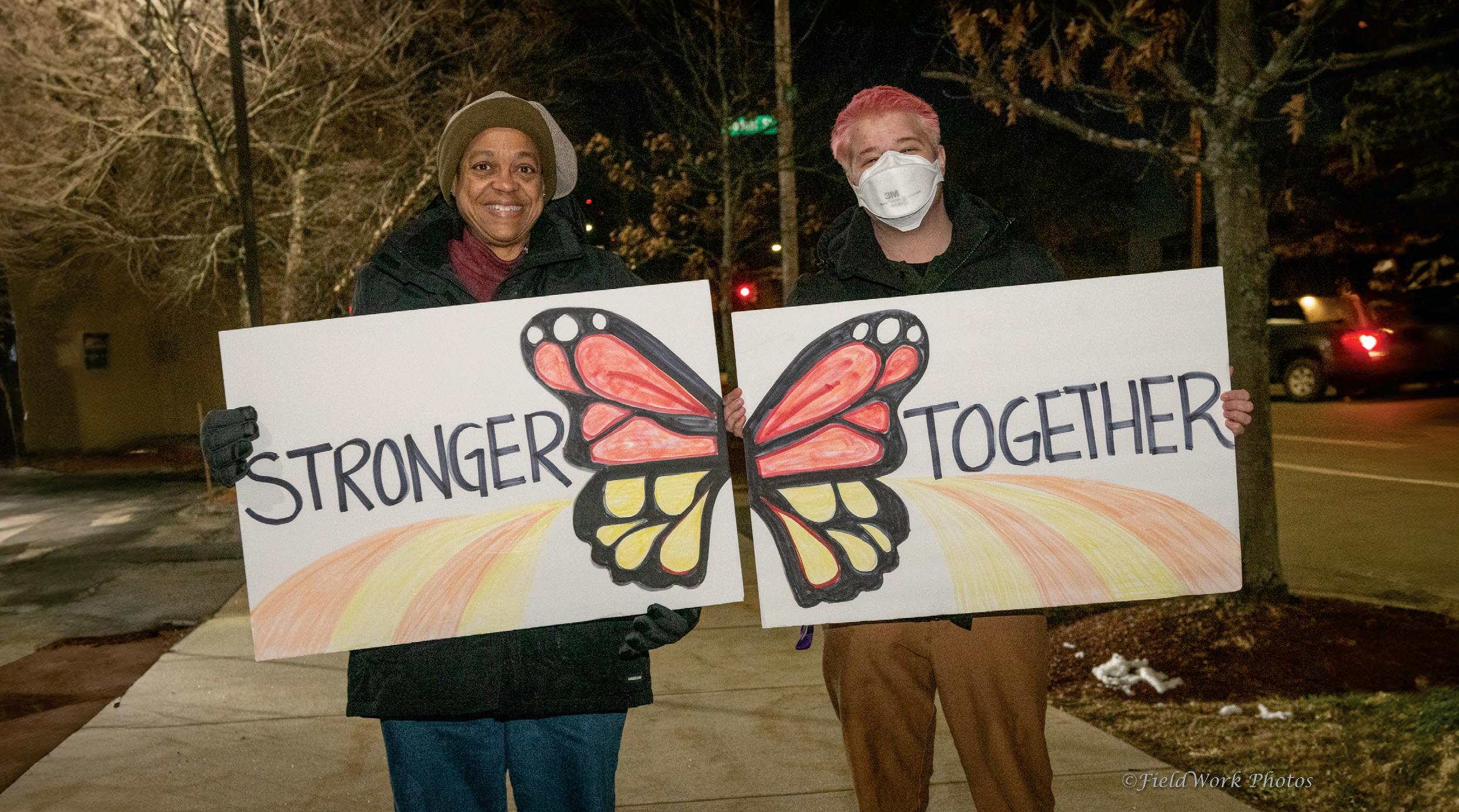
The American Friends Service Committee has been working since 1917 for a just, peaceful, and sustainable world. For almost 50 years, the New Hampshire Program has nourished growing movements of people calling for social, racial, and economic justice. We advocate for the rights and well-being of immigrants. We honor and elevate the leadership of directly impacted people. And we engage diverse stakeholders in organizing for positive change.

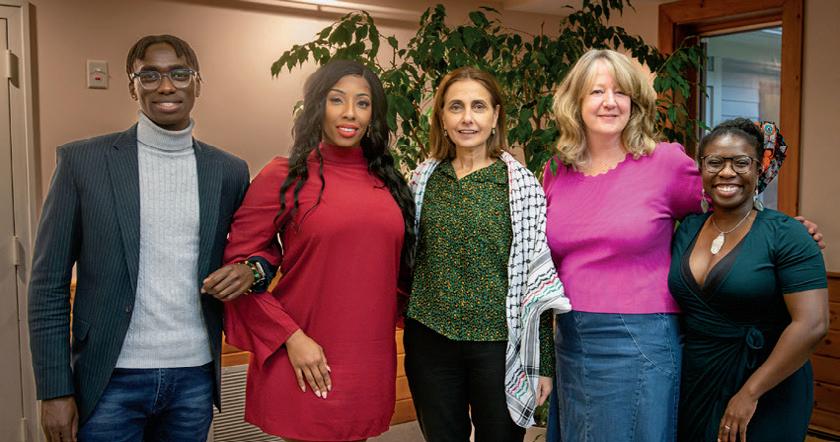

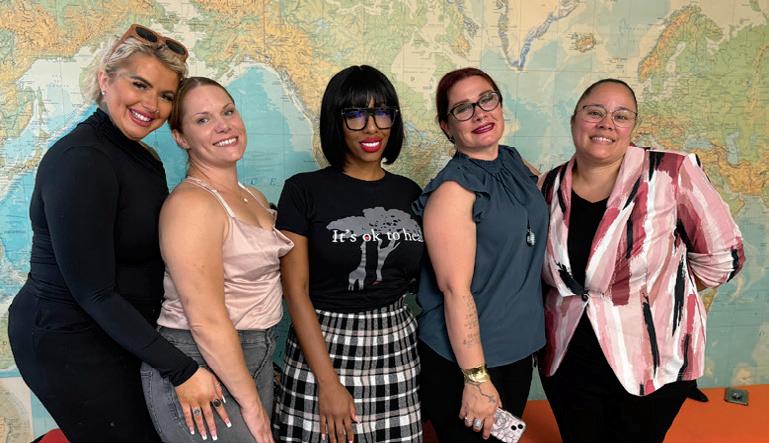


Iwas recently honored to be asked to give a TEDx talk in Manchester. I didn’t choose a topic related to one of my arenas of professional expertise but rather something much more personal. I talked about the risk of being pigeonholed for a lack of ability, and about how the perceptions of these limitations are so often misguided.
One of the stories I told was of how my first-grade teacher, convinced that I was beyond hope when it came to learning the alphabet and reading, told my mother they’d be moving me to a slow track group, but not to worry, because “not everyone is cut out for academics.”
he now shares with others facing the same challenge through the organization he leads, Future In Sight.
In the beginning, he says, it’s hard for people to imagine how they will ever be able to do the things they love, or even just the things they need to do to maintain their lives.

For many kids, this might have been the beginning of a lifetime of lowered expectations, both external and internal. If I had grown up believing I “wasn’t a good reader,” it’s likely I never would have been. My mother, however, did not accept that assessment. She understood that my intellectual capacity wasn’t defined by a specific developmental moment or learning style, and she undertook to teach me to read herself. Within three years I was reading so avidly and so far above my grade level, I was teased for using too many big words. I finished high school on an honors English track, published several novels, and have spent my career as a writer and publisher. Surprising, for a kid “not cut out for academics.”
I share this not to brag about my prowess with the language – I know just enough to know how much I still have left to learn. Rather, I was reminded powerfully of this story while spending time with the subject of our cover story, Randy Pierce.
Randy went blind suddenly as a young man and had to go through a tremendously difficult period of adjustment and grief. And he had to go through a radical shift in perspective about what was possible for a blind person.
This shifting of perspective is something
Cooking is a perfect example. How do blind people cook? Seems impossible, and dangerous, not only to the newly blind, but also to their loved ones. Well intentioned loved ones may want to prevent them from even trying. But as Randy points out, “cooking without looking” is entirely possible, it just requires a shift in perspective and a whole new set of strategies and tactics.
In the story, you’ll read about some incredible ways Randy defies expectations of what the world considers should be possible for a blind person. His achievements serve not just as an inspiration for other blind people, but as a powerful lesson on how the world in general – including potential employers –should view the disabilities community. So many of the limitations the world perceives of the disabilities community, in the workplace and in general, are misperceptions.
Using tactics including skill adaptations, environmental adjustments and alternative methods, a universe of possibilities exists, from the dramatic (Randy loves axe throwing) to the quotidian grind of household chores. “You know my washer and dryer have little bump dots, so I know where to start or where the settings I need are, so I can’t tell my wife, ‘No, blind guys can’t do laundry,’” Randy said with a laugh, “as much as I might want to.”
Beyond our story about Randy, this issue of 603 Diversity is full of further examples of remarkable people transcending perceived limitations, breaking through barriers and continuing to make New Hampshire a remarkable, diverse place to live and thrive for all. 603


As

Contributing Writers
Vanessa Weathers
James McKim
Alberto Ramos
Ernesto Burden
Trisha Nail
Emily Reily
Sarah Pearson
Amara Phelps
Yasamin Sarfarzedah
Suzanne Laurent
Contributing Photographers
Robert Ortiz
Contributing Artist Richard Haynes
Editor/Publisher
Ernesto Burden x5117 ernestob@yankeepub.com
Managing Editor Mike Cote x5141 editors@603diversity.com
Managing Editor, Custom Publishing Sarah Pearson x5128 sarahekp@yankeepub.com
Creative Services Director Jodie Hall x5122 jodieh@yankeepub.com
Graphic Designer Christian Seyster x5126 christians@yankeepub.com
Senior Production Artist Nicole Huot x5116 nicoleh@yankeepub.com
Sales Executive John Ryan x5120 johnr@yankeepub.com
Operations Manager Ren Chase x5114 renc@yankeepub.com
Digital Operations and Marketing Manager Morgen Connor x5149 morgenc@yankeepub.com
Billing Specialist/IT Coordinator Gail Bleakley x113 gailb@yankeepub.com




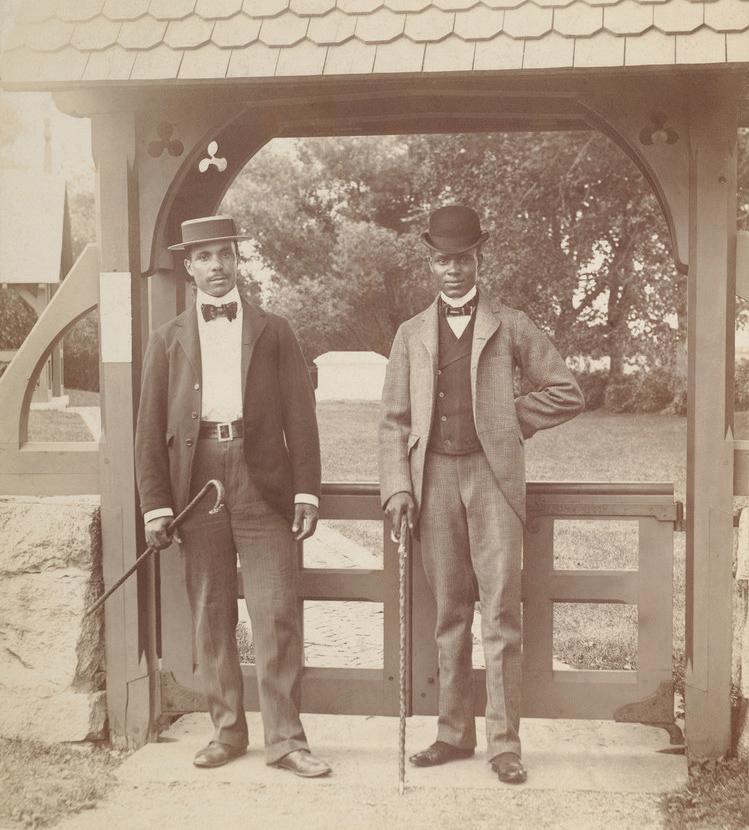




To illustrate the mission of 603 Diversity, Seacoast artist Richard Haynes has provided one of his recent designs to accompany our motto “Live Free and Rise.” We are selling T-shirts and other merchandise featuring Haynes’ design, or a design created by art student Chloe Paradis, to benefit the Manchester Chapter of the NAACP Visit 603Diversity.com to buy one today.





The 603 Diversity underwriters provide a significant financial foundation for our mission, enabling us to provide representation to diverse communities and for diverse writers and photographers, ensuring the quality of journalistic storytelling and underwriting BIPOC-owned and other diverse business advertising in the publication at a fraction of the typical cost. We’re grateful for our underwriters’ commitment to diversity, equity and inclusion in this magazine, their businesses and their communities.
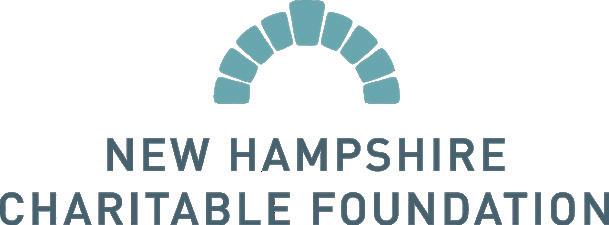
It takes more than love to care for a loved one. Help is Here. Get the caregiving support you need when you need it.
No one ever hopes to become a family caregiver. But it’s a role you and 168,000 others in New Hampshire play every day. No matter how much you love the person you’re caring for, being a caregiver can be a lot to manage.
AARP Family Caregiving is here to help. We can make it easier for you to get answers, help you connect with and learn from other family caregivers and guide you to useful resources online and close to home.
To learn more, visit aarp.org/caregiving

/aarpNH @aarpNH









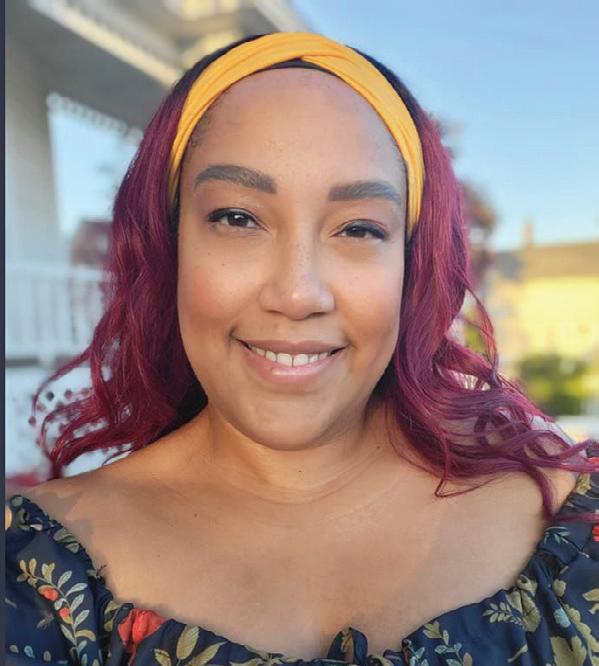
Vanessa Weathers is a devoted stayat-home mom who has always been passionate about community and wellbeing. As a neurodivergent individual, Vanessa brings a unique perspective to her work. She created a digital community for Black women in NH that now has over 600 members and leads a committee dedicated to establishing a social club that prioritizes the needs of Black women, femmes and nonbinary individuals.
As publisher of New Hampshire Magazine, the New Hampshire Business Review, and 603 Diversity, Ernesto Burden is usually involved in the background of the story process. However, in this issue, he also laces up his sneakers as a running guide and scribe for our cover feature on Randy Pierce. An athlete himself, you might spot him running around Manchester or at the 2025 Boston Marathon next April.

Emily Reily joined Yankee Publishing as an assistant editor with New Hampshire Group in September 2023. Emily writes for 603 Diversity, New Hampshire Magazine and other Yankee publications. Her work has appeared in various local and national newspapers including New York Times for Kids and Washington Post Magazine. A former newspaper photojournalist and current music critic, Emily lives in Dover.
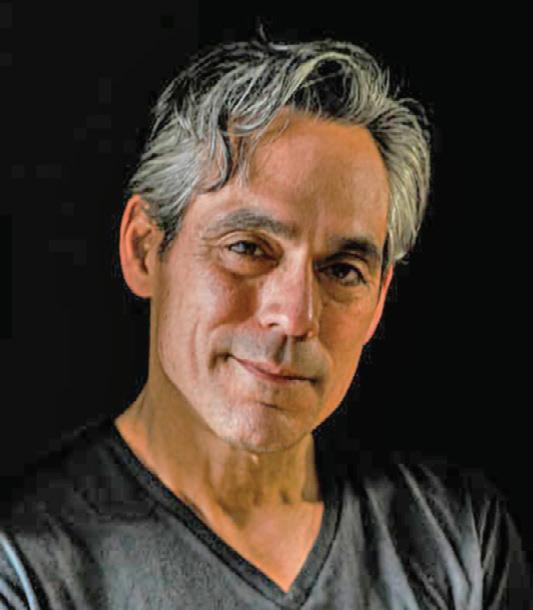
Musician and community organizer
Amara Phelps loves to engage with her city of Manchester in more ways than one: fronting her popular local rock band Cozy Throne, teaching and sharing art in southern New Hampshire, and promoting community events and efforts for local publications, including Manchester Ink Link.

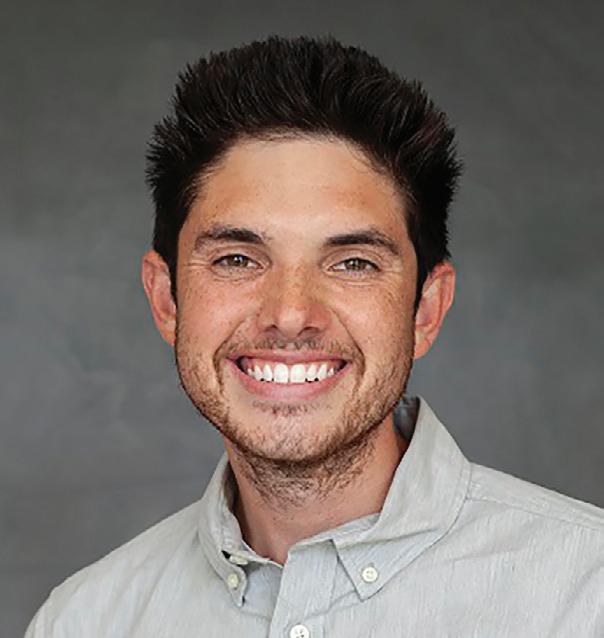
Alberto Ramos heads the recently formed Center for Inclusion, Diversity, Equity and Access at Plymouth State University. He serves as the chief diversity officer and affirmative action officer. He has partnered with PSU Black and Latinx student unions, PSU Pride, the Multicultural Club, faculty and staff to form a council of principal advisors and launched a Student Leadership Program. Ramos holds an M.A. in teaching English as a second language, and a B.A. in communication studies and travel and tourism.
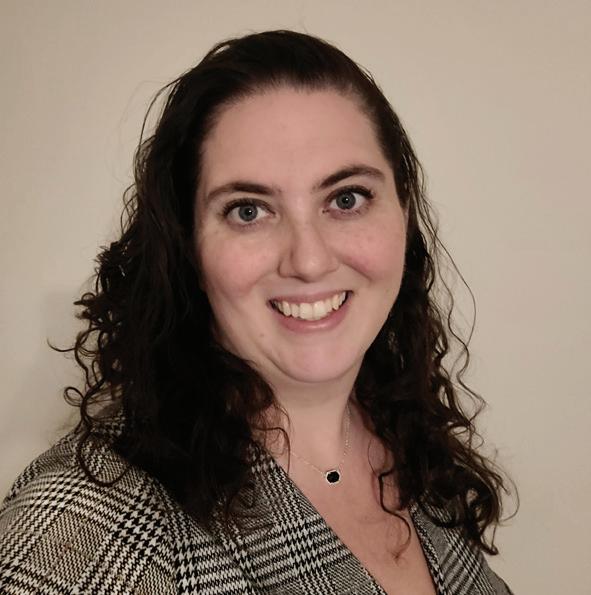
Sarah Pearson is managing editor of custom publications for Yankee Publishing, which produces 603 Diversity and many other titles. She is an awardwinning editor and journalist who previously worked for a newspaper. She is a lifelong New Hampshire resident and mother of two boys.

James McKim, who was involved in the original plannng of 603 Diversity and has written essays for past issues, serves as managing partner of Organizational Ignition. He is driven by an intense need to help organizations achieve their peak performance through the alignment of people, business processes and technology. He is recognized as a thought leader in organizational performance, the uses of neuroscience and program management.
After a stint in daily newspaper work, Trisha Nail became NH Business Review’s assistant editor in 2023. She was previously the business reporter of The Keene Sentinel based in the Monadnock Region, following four years of undergraduate journalism studies and community reporting in her native Alabama. She holds a bachelor of arts degree in journalism from Auburn University. Trisha resides in Concord, New Hampshire.


Raised in a diverse community in Boston, Massachusetts, Suzanne Laurent worked as a registered nurse for the Boston Head Start Program. She moved to Toronto, Ontario, in 1982, and unable to work as a nurse, Laurent pursued a career in photojournalism. She has been a resident of New Hampshire since 1987. She has an extensive awardwinning background in journalism. She is also a juried photography member of the New Hampshire Art Association and a published poet.
603 Diversity stories emphasize not only how things are, but how they might or even “ought” to be as we seek out and reveal our state’s diverse communities. When we needed a single image to summarize the mission of this magazine, we went to a man who has long been telling complex stories with bold strokes of color and universal symbols. Artist Richard Haynes provided a selection from his recent work for this purpose. See page 4 for how you can fashionably spread the good word.

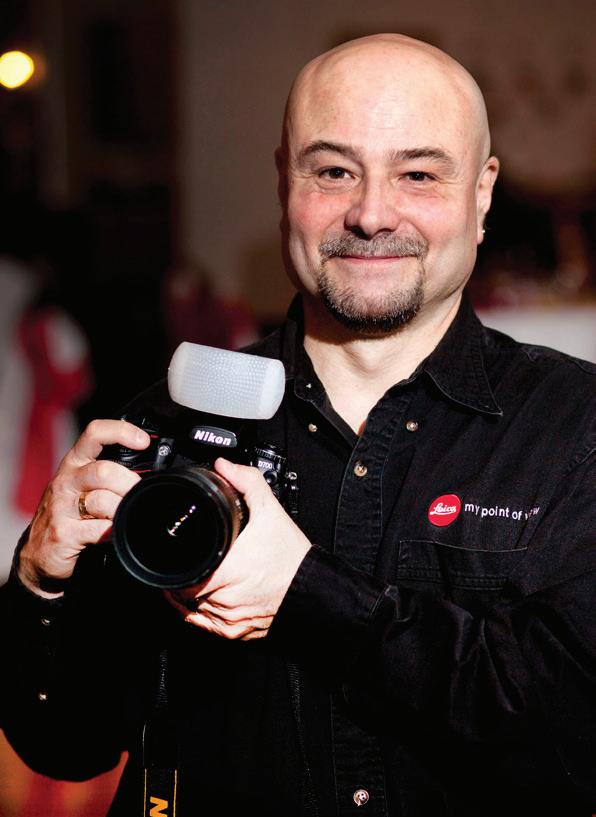
Primary photographer for 603 Diversity is Robert Ortiz of Robert Ortiz Photography. Ortiz began his photographic career at 15, and has chronicled everything from local weddings and events to the lives of the native peoples of the Peruvian Amazon. He lives in Rochester with his wife and son and 15-year-old daughter, Isabella, who is currently in training as his photo assistant.

Advocate, coordinator and educator
Yasamin Safarzadeh, a native Angelino and current resident of Manchester, compiled our calendar and wrote the feature on the UNH researchers. Safarzadeh hopes to secure a future for a more diverse young adult population in New Hampshire to ensure a more prosperous and effective future for all. DM her at phat_riot on Instagram.

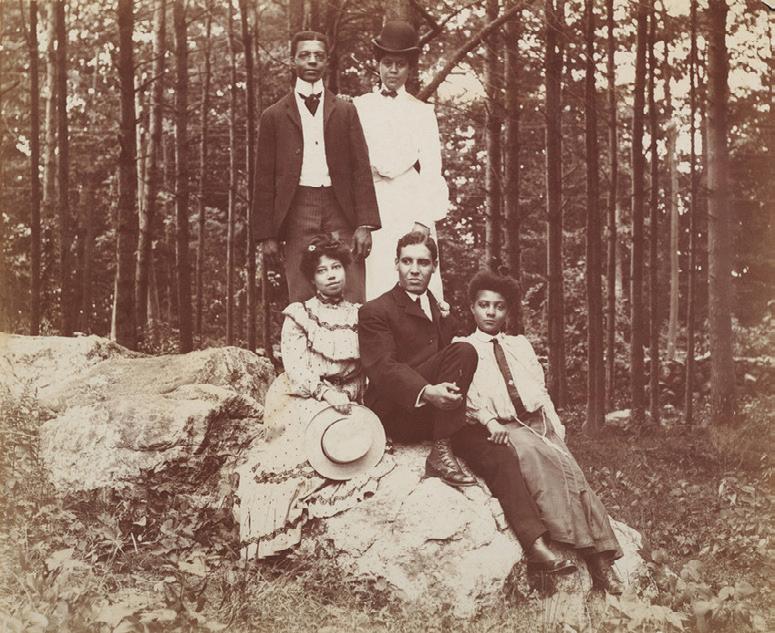



BY ERNESTO BURDEN
The lives, labors, worship and tourism of Black Americans on the New Hampshire Seacoast are strikingly illustrated in a trove of photos recently acquired by Historic New England. The 375 photos date from the turn of the 20th century during the golden age of grand hotels.
According to Lorna Condon, senior curator of library and archives at Historic New England, the acquisition of these photos aligns with a new approach Historic New England is taking in building its collections. A new formal collecting plan released in 2023 acknowledges that “a key limitation of the collections is that they reflect the collecting history of mostly elite, white, Protestant residents of New England, and those primarily residing in Massachusetts.”
As Historic New England looks to expand the diversity represented in its collections, it also seeks to “create more opportunities for community collaboration, and to empower more people to tell their own stories.”
Condon hopes the publication of a sampling of these photos in 603 Diversity may lead to more information about the people pictured and the lives they led.
“Photos like this are going to allow us to look back and tell the stories that we haven’t told in the past,” she says.
The photos were taken by Clarence Trefry (1870-1958), who lived in Rye for several decades. Many of the photos are annotated in Trefry’s handwriting.
According to the description of the lot provided by James E. Arsenault & Company, from whom Historic New England acquired the collection, “Although there are records of a small number of enslaved people of color in Rye during the 1700s and early 1800s, and there has been an established Black community in Portsmouth dating from the same period, it is unclear whether there was a permanent Black community in Rye when Trefry was active there in the late 1800s and early 1900s.”
In addition to the African Americans shown here, the collection also includes images of Native Americans, likely Penobscot people, other residents of the region, and Spanish prisoners of war as well as landscape and architectural photos.
The collection is currently being cataloged and digitized. Readers will be able to see it on Historic New England’s website (https://www.historicnewengland.org) in the spring of 2025.
If readers have any information about the images, they can send an email to archives@historicnewengland.org. 603


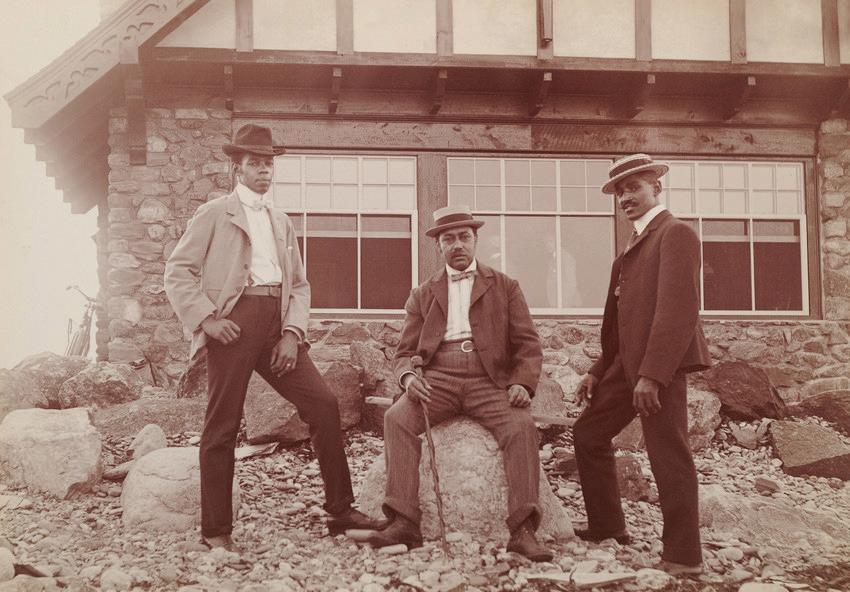
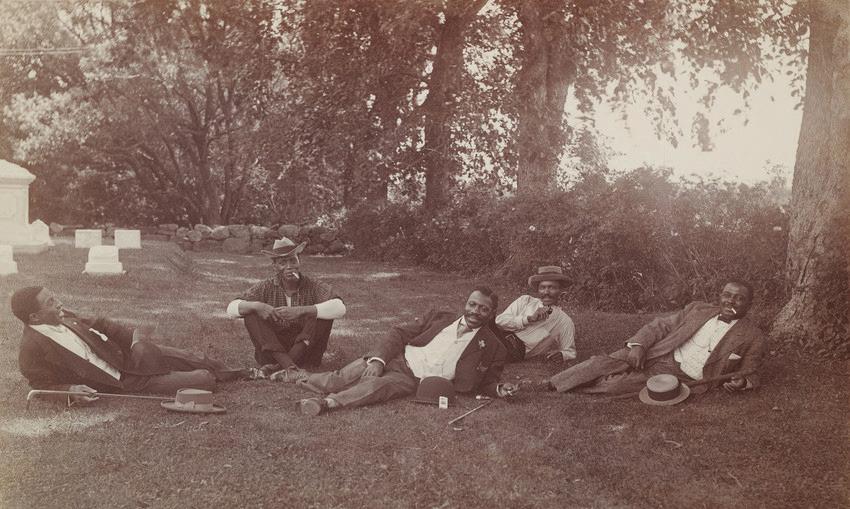
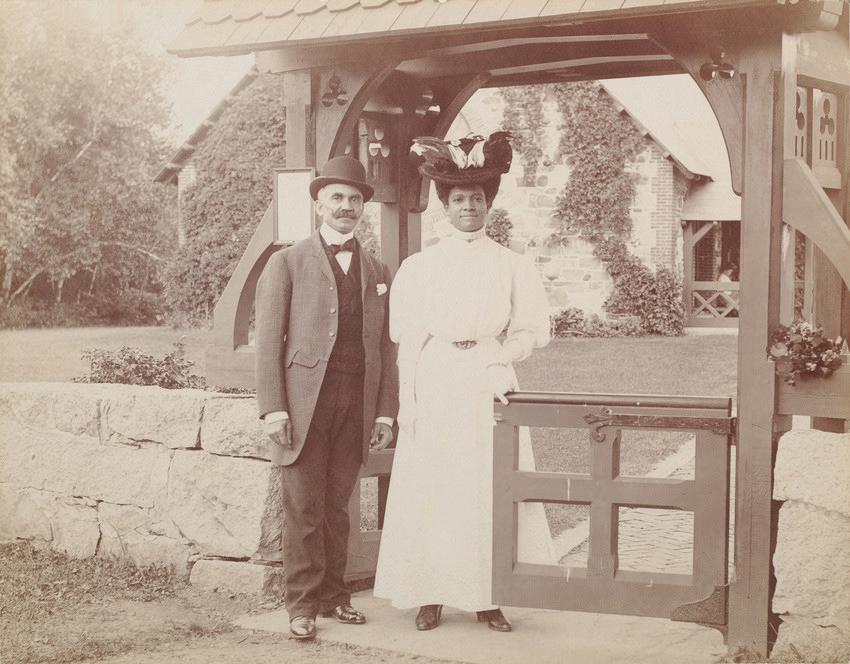

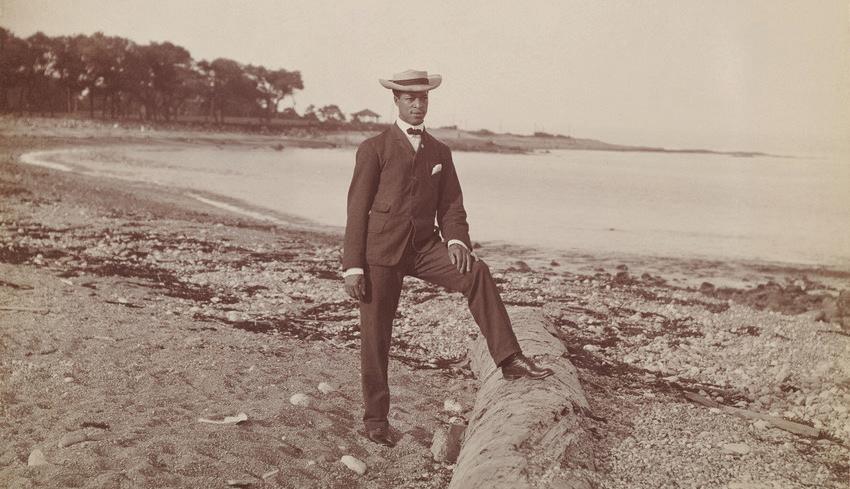

Positive Street Art, known for large-scale artworks on buildings across Southern New Hampshire, added a splash of color to one of Manchester’s most diversely populated neighborhoods. A new mural was recently unveiled at the historic Sheehan-Basquil Park after weeks of efforts this summer from a crew led by Yasamin Safarzadeh. With a program structure and mural design that Safarzadeh describes as “highly unique,” the work was completed by many hands, partnering with organizations like Opportunity Networks, Waypoint NH and MYTURN.
“An integral component to programming like this is having both youth and adults from different programs, both teaching and learning, and being compensated. Both being platformed and amplified in their expression, given access to higher quality of materials, raising expectations
and living up to their potential,” Safarzadeh says. The team used this frame of mind to tackle the project.
Sporting three baseball diamonds alongside a soccer pitch, the park has supported city Little League teams since the mid-1940s, when the league was even photographed for Life magazine. The triplet set of fields is the home of Manchester Central Little League (MCLL), which offers multiple age brackets of baseball in the often-underserved neighborhood. The league provides adaptive teams specifically designed for children who may need accommodations due to disability. A small side field becomes a hard field soccer pitch, which MCLL uses to facilitate a visually impaired soccer team that hosts from global locations such as South America and Africa. In the heart of the field, a large green clubhouse served as the home of operations for all the park’s various activities. On game nights, it serves up

popsicles and chips to spectators. This summer, it became host to Positive Street Art’s mural program. The mural, which spans most of the east face of the clubhouse, was an intersectional collaboration between Positive Street Art and their partner organizations. A team of more than 50 artists created a unified vision for the design.
Facilitator Roger Balcom recalled the uphill battle the team faced in undertaking the project. “We endured a lot of harsh temperatures, working outside in the sun while grinding against a strict timeline,” Balcom says. “Even facing a lack of resources and so many complications, everyone was tireless during the project. With such a small team, we cleaned up what some saw as a lost cause and turned it back into a functional clubhouse.”
Balcom notes how the group upheld a strong team mentality through the summer. “We lifted each other up the whole time. Seeing everyone else pushing onward, de-
spite exhaustion, inspired me to give everything I had,” he says. “Catching the student interns smiling and expressing the real fun they were having was another highlight.”
Based on contributions and personal touches from participants, the mural nearly comes to life in its dynamic motion, color and conceptual diversity that aptly reflects the community who created it. The art continues into a technicolor interior, which saw washes of paint across the two floors as the team faced uncooperative weather and the removal of decades of stubborn anti-graffiti paint. Unable to track down a proper solvent, the team took to the walls with concrete sanders and scrapers, exposing thick layers of past paint jobs. Even in the face of such challenges, the team pushed the execution of the mural from priming to completion in less than six days.
“A six-week program, and the mural was erected in the last six days. On the seventh day, we rested,” primary facilitator
Nathaniel Pepe says.
The project culminated in an unveiling celebration packed with guests, including newly elected mayor Jay Ruais, alongside neighborhood families and collaborating artists. Guests were welcomed to delve into the clubhouse’s redesign, following each color to the awaiting gallery space created from the group’s conceptual drafts. Afrobeats tunes underlaid mingling as the afternoon built to featured performances from Akwesasne vocalist Bearfox and New Hampshire rock band Cozy Throne, alongside reflections from artists and leadership members. The team has once again stayed late to help clean up the festivities, as Safarzadeh shares her belief that the true lasting effect of this project is more than just the mural itself.
“It is living in each person who healed a little more in each facilitator, to each participant and each passerby, and each person who uses the park for shelter,” she says. “All of these things keep me going.” 603
“She gave me my life back.”
“It started out as a normal outing. My wife and I had to run to the grocery store. We were driving down the road casually going over our shopping list when the car ahead of me started to slow down anticipating the yellow light. I started to move my foot from the gas to the brake as any normal person would do when they see brake lights in front of them, but I couldn’t. I couldn’t feel my foot. The car kept moving forward and I just couldn’t get my foot on the brake and CRUNCH! I finally came to a stop when I hit the car in front of me.”
This tragic story was shared with us by Mike S., a New Hampshire resident who has Peripheral Neuropathy. While no one was hurt in this accident, Mike S. had suffered almost every day of his life with tingling and burning in his feet until numbness set in, and he could no longer feel even the brake pedal beneath his foot.
That’s where Dr. Markwith and her staff at Trend come in.
“About 80% of our current patients come to us suffering from the same condition as Mike,” tells Dr. Markwith.
“They’re in constant pain from neuropathy and it prevents them from not only living their lives but more importantly, it prevents them from enjoying it. Depending on the severity of


their nerve damage, we typically see tremendous progress in 3-4 months of treatment. I like to say we’re in the business of making your golden years golden.”
“I can’t lie,” confides Mike. “I was skeptical at first. So many specialists told me there was nothing that could be done and then there’s a doctor right here in Concord tells me she can help. Turns out she was right! About three months after treatment I was able to confidently drive myself to my appointments! My wife and I celebrated by buying ourselves a new car. It’s hard to put into words how incredible this is, quite frankly [Dr. Kristen] gave me my life back.”
You can learn more about Dr. Markwith and Trend by visiting TrendAcupuncture.com or call (603) 456-8294 to schedule a complimentary consultation.
BY YASAMIN SAFARZADEH / PHOTO BY ROBERT ORTIZ
In July, Louis Esposito joined Advocates Building Lasting Equity in New Hampshire (ABLE NH) as its new executive director. ABLE NH is New Hampshire’s lobbying arm for the disability community. 603 Diversity met up with Esposito at Sheehan-Basquil Park during a fully integrated mural internship this past August. He’s a man who is not afraid to get dirty, climbing ladders, passing out popsicles and water, and working with staff from Opportunity Networks on the mural. The staff and participants seemed overjoyed to hang out with him. Wearing white-framed sunglasses and a tie-dye T-shirt, Esposito doesn’t give off the vibe of what you might imagine of a nonprofit executive. He’s invested in practices of organizational management: authentic, intentional, accessible and informed.
Q: We always start these things with the most obvious question, what is ABLE NH? Why do we need it? What’s the elevator pitch?
Louis Esposito: I’m gonna start with my background a little bit. Before ABLE, I was a special education teacher. I worked with students who had emotional disturbances ... a technical phrase that I hate. Before that, I was the program director at Opportunity Networks for several years. Which was very cool because they really have a people-first approach. It got to a point where I was tired of feeling ill-adapted to address the problems my students and their families faced on a larger scale. There are a lot of systematic issues, which I felt I couldn’t change from my positions.
Q: That is actually something really unique about Opportunity Networks, which is covered in “Updating an Icon” (page 10). Its programming is more integrated and up-to-date than other programs nationally in addressing a non-isolationist approach to community members who have disabilities.
Esposito: And that’s sort of what you see sometimes. On a weekday afternoon, you might see adults with disabilities sort of wandering around the mall with no money to spend for shopping or eating at restaurants ... and so many organizations are turning away from that approach and moving towards more intentional, creative and community-based programming for constituents. That’s when the


question comes up then, what is true inclusion? Sure, there’s work programs, but what else? There are some art-making programs, and this summer’s mural internship with Positive Street Art was an example of that. I loved visiting the site and having art shoved in my face and having programming participants selling me their stuff for $30 a pop.
Q: Another major roadblock is people’s preconceived misconceptions of the capabilities of adults in these environments and frustration with behaviors, which happen to be purely circumstantial.
Esposito: That’s exactly it. You cannot approach people with anger. You don’t know the entire picture that paints the life of an individual; the feelings of lacking confidence or abandonment. And we never know what in all this creative and intentional programming will have permanent and lasting, positive affect on people. Connections with the community will have lasting impressions for people. I am thinking of systemic approaches versus materials-based approaches. Inclusive approaches look like stopping the removal of young people from settings with others their age. When you remove them and isolate them so that everyone around them grows up and moves on, they are trapped in the same place watching the world move. (Inclusivity) is so impactful for social learning.
Q: But why wouldn’t schools want to separate different leveled learners from each other? Wouldn’t it benefit people to be moving at their own pace?
Esposito: There are a lot of assumptions involved with isolating young people from each other. Negative connotations on “special education.” It is a disservice to people who are not in the disability community by creating these silos and essentially taking away potential lifelong friendships and compatriots.
Q: I never thought of how much the community is missing out by continuously isolating and marginalizing members of itself for being different. What are some other avenues ABLE NH is advocating for?
Esposito: Dental care is a major issue with people. Another approach to how we employ individuals involved in disability work: Why can’t the staff and guardians be compensated correctly? It’s bonkers that they are working so hard and have the care of an entire human being in their hands and are paid mostly $15-$20 an hour. Housing is another major issue. Often there are housing bills on the floor of the Capitol and people don’t think about how many marginalized demographics these bills are actually impacting. Transportation is another major issue, as is a lack of dual diagnosis health care.
These are all avenues ABLE NH is able to advocate towards in order to ensure equity for all of our community members, especially community members who are people with disabilities.
Q: What is your approach when you think of your leadership style?
Esposito: I guess I want to stay accessible. My background is from a myriad of different fields. Social, emotional and now I am in a doctoral program. So, I am thinking about the autonomy of people. When does an individual need to disclose their whoness? How can we flip the script where the social construction around disability is the issue and not the individual? By focusing on the lived experiences of disabled individuals and promoting leadership that highlights these perspectives, we can create more inclusive and accessible spaces. It’s about challenging ableist structures and creating systematic changes. We need to recognize that disability is a social construct rather than an inherent flaw in an individual. The flaws are the barriers created by institutions and society that fail to accommodate human diversity. When society is unwilling to make this space, it creates the condition that marginalizes individuals. The problem lies in the system’s lack of inclusivity not in the person’s existence.
So, to go back to your first question,
what is my elevator pitch? I want to be able to lead an organization that highlights and amplifies people from the disability community. We have groups in NH that are run by people with disabilities themselves like SALT (Self Advocacy Leadership Team) and People First of NH. These are two strong organizations with amazing and dedicated people. So, I guess we need infrastructural change to make this a norm in more settings. I want to amplify the voices of people with disabilities and address the problems that they face in living in an inclusive society. By focusing on the lived experiences of disabled individuals and promoting leadership that highlights these perspectives, we can create more inclusive and accessible spaces. It’s about challenging ableist structures and creating systematic changes. This is a holistic issue.
Q: I just signed up to be a member of ABLE NH because I wanted to be up to date on what policies are affecting the disability community, and I didn’t think the monthly charge was too steep. Are there other cool things a person gets when they sign up for a membership with ABLE?
Esposito: The reality is we do not get any state or federal funding because we do policy advocacy. The memberships help immensely with our efforts. People do get emails about what is going on on the ground. They will have a direct voice in the direction of the organization. They will have access to training which will help to foster more inclusive placemaking and educational environments. Anyone can be a member, but ideally, we need more engagement from the disability community.
Q: In October was the annual Disability Justice Parade. Last year it was at Arms Park in Manchester. How was it this year?
Esposito: This year we planned to walk up Main Street in Concord right to the lawn of the capital building. This was on Saturday, the day after our Friday conference, “The Art of Advocacy” at the Holiday Inn in Concord. If you want to know more about what we’re doing, visit our website at ABLENH.org. It’s pretty informative and very easy to navigate. And if y’all have any questions about joining up and helping out, email info@ablenh.org.


LEARN MORE WE DARE TO CREATE A MORE PERFECT GRANITE STATE, DO YOU?

BY TRISHA

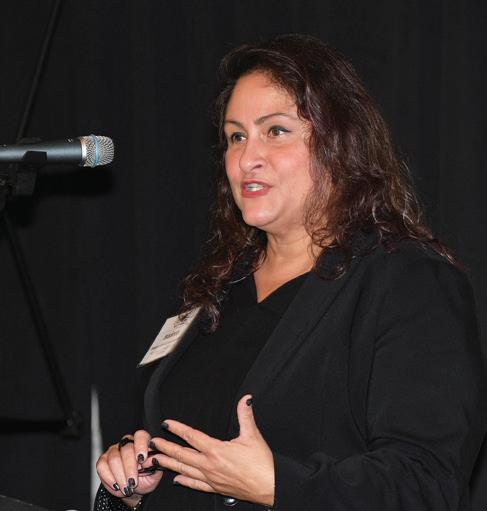



When it comes to hiring employees with physical and intellectual disabilities, their conditions require resiliency over resistance. That was the message from several employers and disability consultants at NH Business Review’s annual DEI: From Talk to Action seminar.
This year’s event on Sept. 19 welcomed eight speakers and panelists to share their experiences of weaving disability inclusion into the workplace, which they said can help rather than hinder companies if managed effectively.
Benjamin Adams, director of workforce development and youth transitional services at Easterseals NH, referred to this approach as customized employment, where those with disabilities can better maintain jobs when managers tailor their relationship to meet the needs of both parties.
“It means (employers) get away from the standard approach where you post a job, you get multiple applicants, maybe they complete a pre-employment assessment. Then you do that interview and select who you want to hire,” Adams said. “It doesn’t work for a lot of individuals with disabilities; they struggle with it.”
Adams instead encouraged companies to collaborate with job-placement specialists involved with workers with disabilities, allowing
them to review job listings and observe the duties of different open positions. He stressed that this requires time and effort if seeking to hire workers who may be neurodivergent, or who have physical differences from their co-workers, but notes it can create a more efficient organization by having more people to carry out more tasks.
Companies may not intentionally seek out people with disabilities; that was true of Peterborough plant-based food producer Shire’s Naturals. Adam Hamilton, chief operating officer and co-founder of Shire’s, has hired workers who prove to be a strong fit for the business’s operations, and many happen to have autism. The nonprofit NH Businesses for Social Responsibility recently recognized Shire’s for its inclusive environment for autistic workers.
At a time when many companies are struggling to find enough staff, Port City Pretzels has a waitlist of potential employees. The majority of Suzanne Foley’s employees are disabled or have some other difference that can be a barrier to employment. Foley works with employees to find a job that matches their skills, whether that’s in the kitchen or the office.
Adams said when companies make an effort to accommodate disabled workers, they see better employee retention as well as an expanded applicant pool. 603



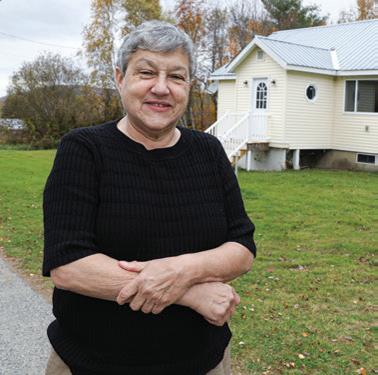

A showcase of culture, creativity and community welcomed visitors to the BIPOC Festival on Aug. 18 at Strawbery Banke Museum in Portsmouth. Dozens of restaurants and beverage vendors shared delicious food, much of it with a cultural focus. Retailers and nonprofit organizations connected Black, Indigenous and People of Color, who set up tables to meet with passersby. A lineup of musicians, dancers, poets and other acts provided entertainment, emceed by Joanna Kelley. The STEMmobile even made an appearance. PHOTOS BY ROBERT
ORTIZ



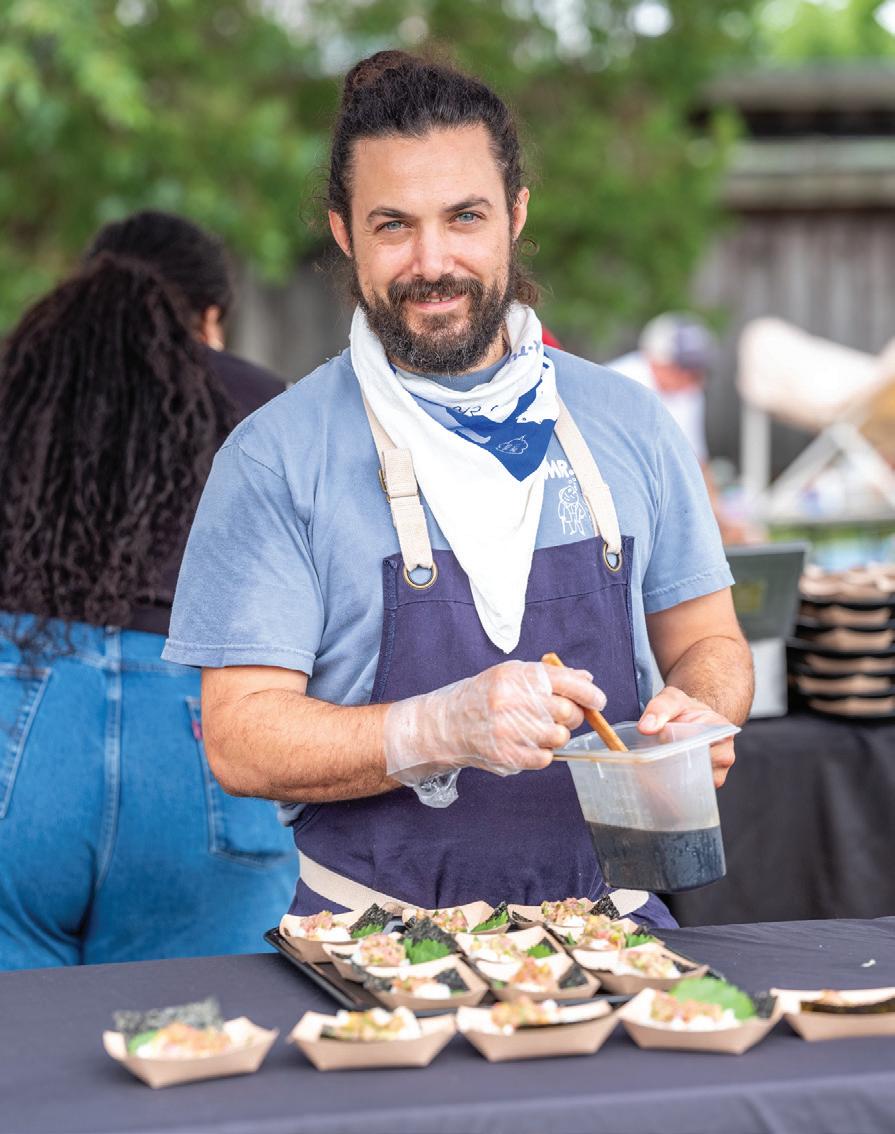





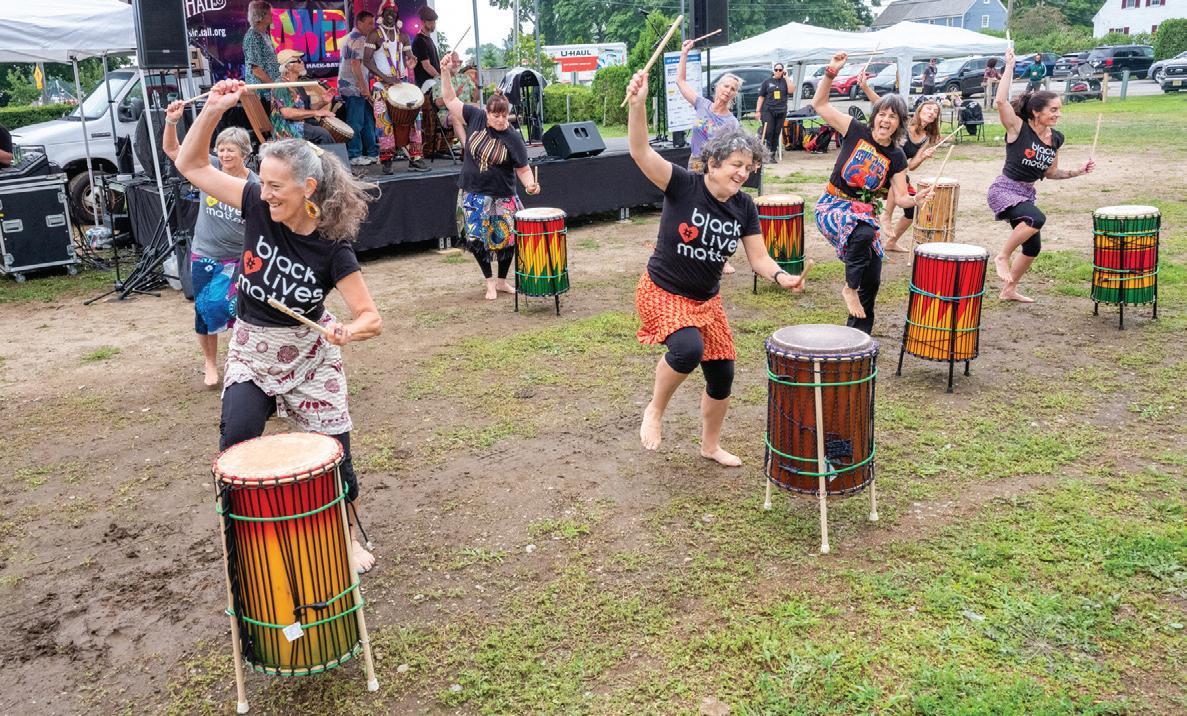

1. Ahura Diliiza from Casco, Maine, shares his Hawaiian roots.
2. Abby and Aaron Djohan; Raude Raychel, founder of Little Indonesia Connect; and Ella Gael Njike, founder of Global Home Care.
3. Jordan Rubin from Mr. Tuna at Portland, Maine, give out free samples.
4. Mariachi band members from “Estrellas De Boston.”
5. Adrienne Mack-Davis from Berwick, Maine, sings her heart out.
6. Drummers from Seacoast West African Dance and Drum – Sayon Camara from Bath, Maine.
7. Annabelle Hunt & Denise Hunt, co-owners of Coastline Seafood.
8. Members of the Seacoast West African Dance and Drum Corps.
9. Latisha Karriman, owner of “Queen Empressa” from Rochester displays her tarot cards for fortune-telling.
10. Chef David Vargas, a festival organizer, and Assistant Mayor Joanna Kelley of Porstmouth are all smiles.
11. Sophie Stewart of Portsmouth.

BY ERNESTO BURDEN / PHOTOS BY ROBERT ORTIZ
RandyPierce had already fought his way through the grief, isolation and hopelessness he felt when he went blind from a sudden neurological disease at age 22. He’d come out the other side determined to reject the perceived limitations of his condition.
He began volunteering as a teacher. He earned a black belt in karate. He built a website about the Patriots that went viral, inspired a fan community, and earned national media coverage and a plaque in the Pro Football Hall of Fame. Then a fluke accident left him suddenly wheelchair-bound.
“It was hard being blind and in a wheelchair,” he says dryly. “My first moments in the wheelchair, I was low, and I remember thinking, you know, first I go legally blind, and then I go totally blind, and now I’m in a wheelchair. When is life going to stop kicking me?”
We’re sitting in his office at Future In Sight in Concord. This is the organization whose support brought him out of his initial, inertial despair after he went blind. They taught him how to navigate the world in a new way. Later they invited him to be on the board of directors. Now he’s the president and CEO, passionately stewarding the more-than-century-old organization forward in its mission to provide support and services to the blind and visually impaired.
It’s late on a Friday afternoon. September sunlight is streaming in the windows of his corner office and his guide dog, Swirl, a black lab, is lying patiently near his feet. We’re wearing shorts and sneakers, sweat still drying after a run up the steep hill toward White Park and then back.
We were taking it easy because it was a hot day, and Randy’s treadmill has been broken so he hasn’t been out in a few weeks. That’s where he logs most of his miles these days. It’s not always possible to coordinate schedules with runner friends who can act as guides on outdoor runs. When it’s working, the treadmill is a saving

grace for a high-mileage runner like Randy.
I’ve run with Randy a few times now, and he’s still working to teach me the ropes of guiding a blind runner. He has to keep reminding me as we run, each holding one end of an ultralight, collapsable cane, to time my audio cues better. “Step up to a curb in three, two, one,” or “There’s a gate with two bollards coming up in about 10 feet, tuck in behind me. Three, two, one.” I usually manage to name the obstacles as we are upon them. My countdown could use work.
The amount of attention, presence and focus it takes to guide can be nerve-wracking initially. A sighted runner quickly realizes when learning to guide how much of what we do when we run is unconscious, taken for granted. Curbs and cars and ruts in the road. Bridges where you have to step up on one side and step down the other. Tree limbs hanging over paths. Randy wears sunglasses while running to prevent those tree limbs from poking his eyes, should his guide fail to mention or avoid them.
This underscores the tremendous courage and trust Randy manifests in so many areas of his life.
I asked him how he came to distance running after ending up in a wheelchair. He says surviving that one year, eight months, and 21 days in the wheelchair made him realize how much he loved being on his feet and moving.
“When I came out, I had a walking stick that I needed for support,” he says. “And it was a long, gradual process. But I celebrate walking. Hiking is walking in great situations. And running is walking

at a little bit of speed. I’ll never take for granted those gifts again. And I’m going to find ways to celebrate them.”
That started his athletic journey. Now that he was up again, he wanted to know how far he could push himself.
The marathon is a 26.2-mile running race. Randy has run 17 of them since 2014. His first one was Providence. His guide dog had recently passed away, and he had a new dog, which he couldn’t leave to go running as often as one normally would to train for a 26.2-mile race. The bonding process is too fragile and critical. So his longest run before that first marathon was 10 miles, which most marathoners would agree is not enough.

“You can guess what happened, and that was no surprise to me,” Randy laughs. Undertrained and suffering, he nevertheless finished the race in 4 hours and 40 minutes. He walked some of it but ran the majority, including the final miles.
“Not always fast, but it taught me a little bit of the grit that you need to do to get through that.”
Grit has been a consistent element of Randy’s story. A core value that comes across in the stories he tells and the speeches he gives. He’s in high demand as a public speaker. He’s got great stories to tell. But he’s also got an underlying passion for what he’s doing that makes every day exciting and mission-driven for him.
He applies the same tenacity it takes to run a marathon or do a Tough Mudder obstacle race to further the aims of Future In Sight.

“I am passionate about this, because this is my way that I can make sure that I’ve given back for the support that got me out of the literal darkest days of my life and moving into believing in myself and what I could be doing. And now this is my chance to make sure that the team who does it is best supported.”
From partners and collaborators to clients to donors, Randy works to “excite and invite” them to the possibilities. He describes the evangelism and teaching he does for the cause, not as filling his audiences up with knowledge as though

they were containers but lighting fires. He’s evoking passion because he knows the difference Future In Sight made in his life and in so many others.
“The blindness challenge leaves people more often isolated and not believing in themselves. They do not believe they have the skills, and so they quit ... they hide, and they stay inside. But I think for many of them, it’s that they think they have no other choice. And that’s what I want to change.”
Randy’s feats, from marathon running to obstacle racing to axe throwing, may seem insurmountably daunting for someone who can’t see. These examples can help provide insight into how many other activities that may now seem impossible to a newly blind or visually impaired person — or to their family members — are still achievable. Whether it’s quilt making, working on a computer, reading a newspaper, or cooking (“cooking without looking,” he jokes), Randy says, with the right guidance, a new way forward can be found.
“It’s a gradual change as you start to realize how much more you can do,” Randy says. “I think the biggest epiphany for me came when I finished my first round of training here (at Future In Sight). I suddenly saw that I could get where I wanted to go. It gets you out of your home, gets you out of isolation and you start connecting. And that can take you anywhere.” 603
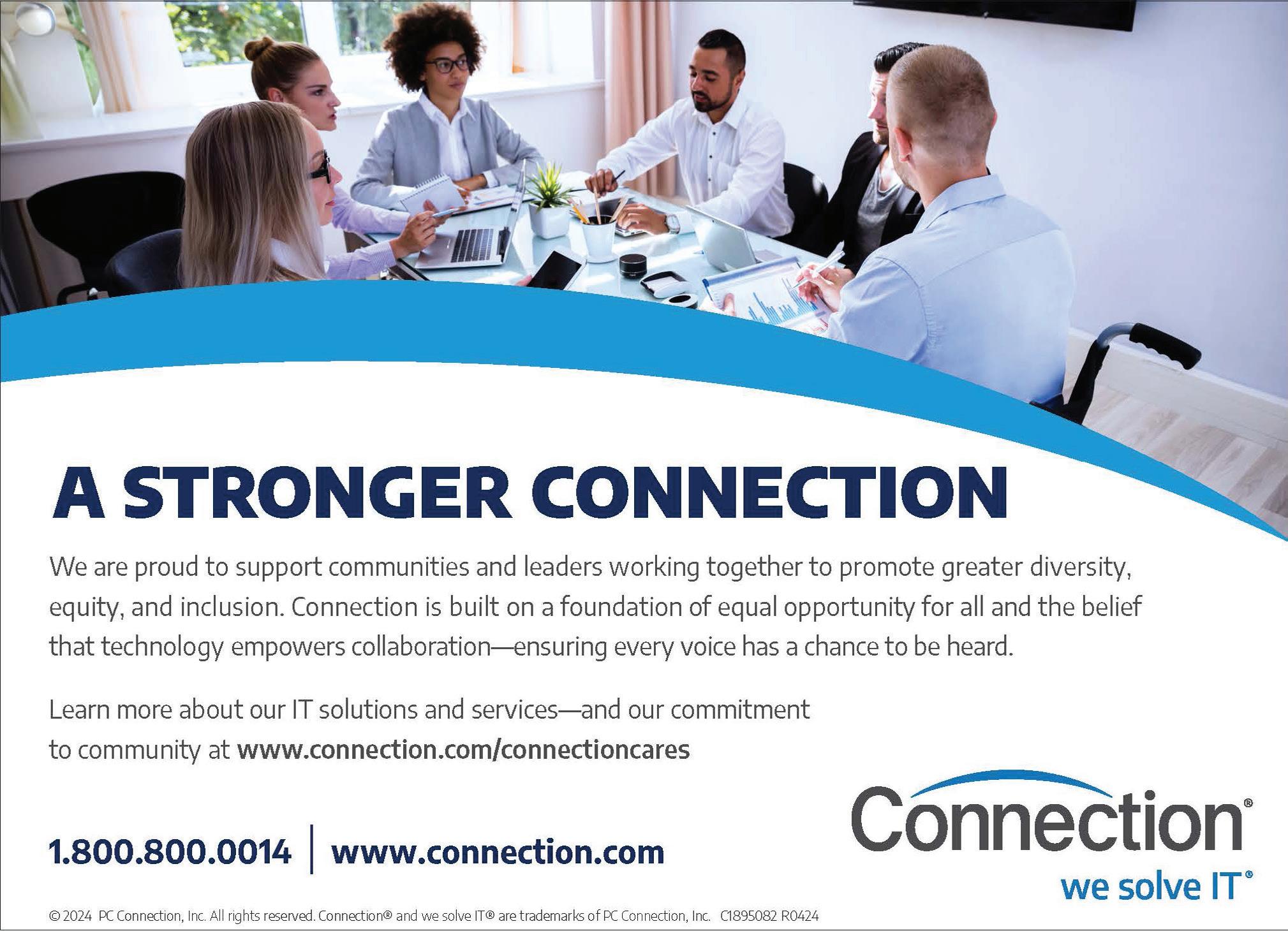
At Enterprise Bank, people and relationships come first. We encourage and foster a culture of diversity, equity, inclusion, and belonging, where everyone feels valued and respected.

“The Bank has great programs for career development. The Commercial Lending Development Program has helped nurture and guide my career as a lender specializing in working with businesses. The various internal committees and Bank-sponsored external cultural events provide opportunities for me to actively support the communities we serve in ways that align with my personal beliefs and values.”
Ana Duprey-Santiago
Commercial Lender | Enterprise Banker since 2022
BY SUZANNE LAURENT
PHOTOS BY ROBERT ORTIZ

splashing
– Ky Hedwall of Nashua was wheeled down to the water’s edge at Hampton Beach State Park by their partner, Vivienne Reynolds, in a special wheelchair designed to navigate rough terrain.
Using a customized walking stick for balance, Hedwall, 27, stood up and tentatively made their way into the water, letting it lap at their feet, relishing in the sensation they have loved since childhood.
Hedwall was participating in BeachAbility, a program offered in July by 20 New Hampshire disability advocacy organizations, including the American Civil Liberties Union of NH (ACLU).
It was the first year ACLU connected NH State Parks with the public to have people with disabilities enjoy a day at the beach. About 100 participants had signed up for the event, according to Katherine Harake, regional campaign manager for ACLU-NH.
“BeachAbility was a resounding success,” Harake said. “It directly connected New Hampshire State Parks with the public on how to create more accessible, inclusive beaches across the Seacoast.”
According to NH State Parks, they were very happy with the turnout, and the input they received was invaluable, Harake added. “They said that it also made them
think of ways to make state facilities more accessible for employees.”
One speaker, Jenn Cowell of Antrim, suffered a spinal cord injury, at the age of 16, ironically while in the ocean.
“I love the beach,” said Cowell, who works at Granite State Independent Living, a statewide nonprofit organization whose mission is to promote quality of life with independence for people with disabilities.
“I tell people to live their best quality of life and not to let their disability hold them back,” Cowell said. “We need our beaches and state parks to be accessible for all.”
Hedwall, who spent some of their childhood on the beaches of San Diego, California, was diagnosed in their teens with Ehlers Danlos Syndrome (EDS), a hereditary connective tissue disorder that affects the connective tissue that supports and protects other tissues and organs in the body and results in joint pain, instability and hyper mobility. This causes joint dislocation and subluxations (partial dislocations).
“I also have a bone disease called fibrous dysplasia. That is not hereditary,” Hedwall said.
Fibrous dysplasia is a disorder where bone is replaced by fibrous tissue, leading to


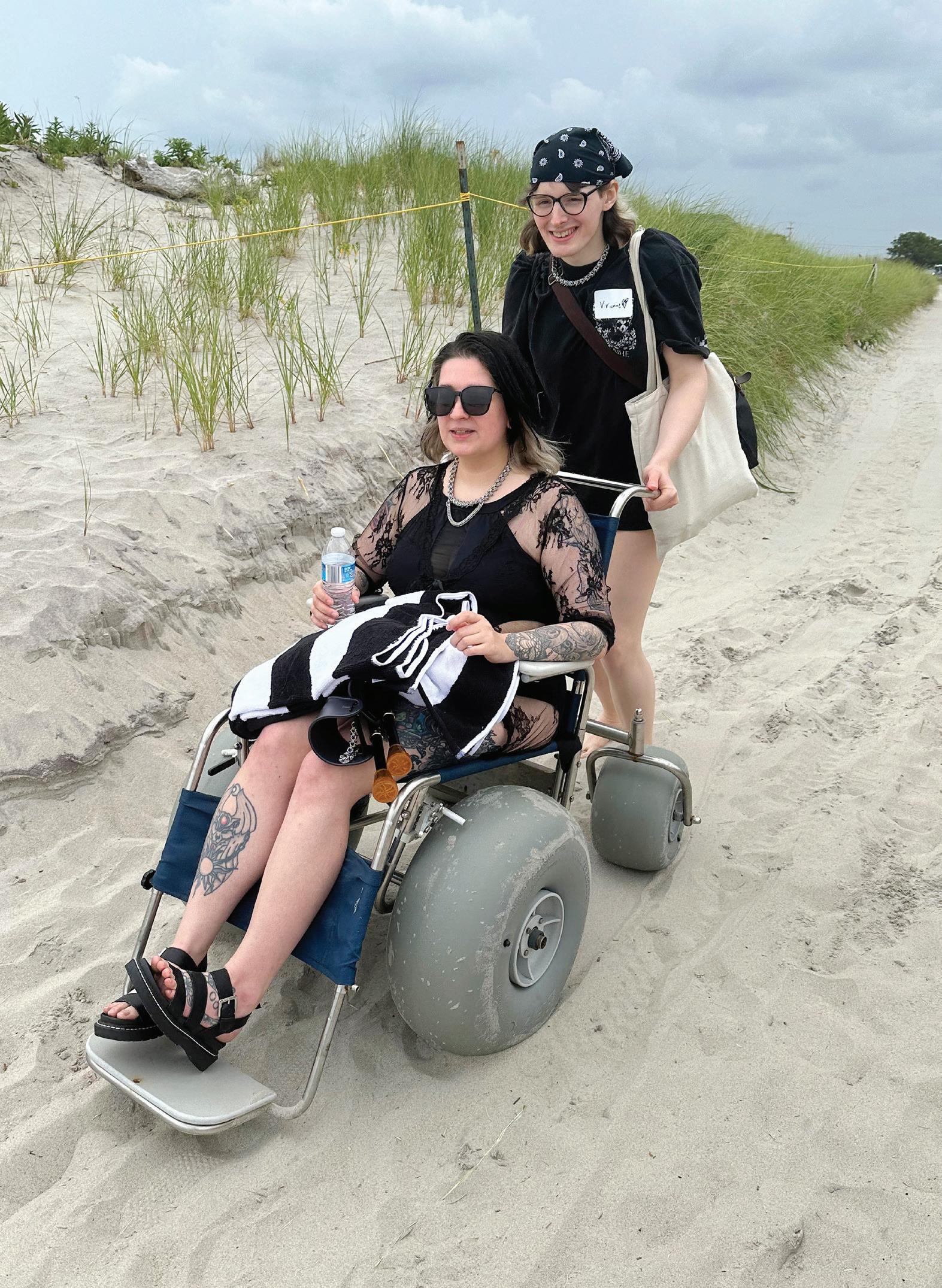
“I had a large area of my left hip and fe mur affected by this, and I had reconstructive surgery when I was 16,” they said. “And I had a few more of the same surgery to try to correct this over the years.”
Their joints healed very poorly after these surgeries, and Hedwall started to struggle with mobility, and the medical team wasn’t sure why.
“I had a few physical and occupational therapists mention EDS to me after they evaluated me and seeing there was a family history, but when I brought this information to my medical team at the time, they did not believe it or want to look into it further,” Hedwall said.
They faced a huge number of barriers
“We need our beaches and state parks to be accessible for all.” — Jenn Cowell

to getting a diagnosis when they were younger for several reasons.
“Firstly, young, chronically ill people often are not believed by medical professionals or insurance — ageism is a huge barrier to rare conditions like EDS being caught and treated early, and often people don’t receive a diagnosis until the problem has significantly progressed and disabled them,” Hedwall said.
“I am an ambulatory wheelchair user meaning I can walk and stand, but use various mobility aids to help me do that due to my hip dislocating when I walk, low energy levels, joint paint, and fainting spells,” they added.
Hedwall said they also faced discrimination in the workplace due to managers assuming they were faking because they

the importance of equal access to
parks and other natural resources.
02 Ky Hedwall of Nashua steps into the ocean at Hampton Beach State Park during BeachAbility.
Photos by Suzanne Laurent
were “too young to be disabled.”
They are currently employed as a case manager/service coordinator at Gateways Community Services.
The BeachAbility event was amazing,” Hedwall said. “It was so amazing to see people in the disability community come out to speak about their experiences and to advocate for change for a more accessible world for us and for people with disabilities that come after us. It’s not just about going to the beach for a day; it’s about making more beaches and public places more accessible.”
“It was so amazing to see people in the disability community come out to speak about their experiences and to advocate for change.”
— Ky Hedwall
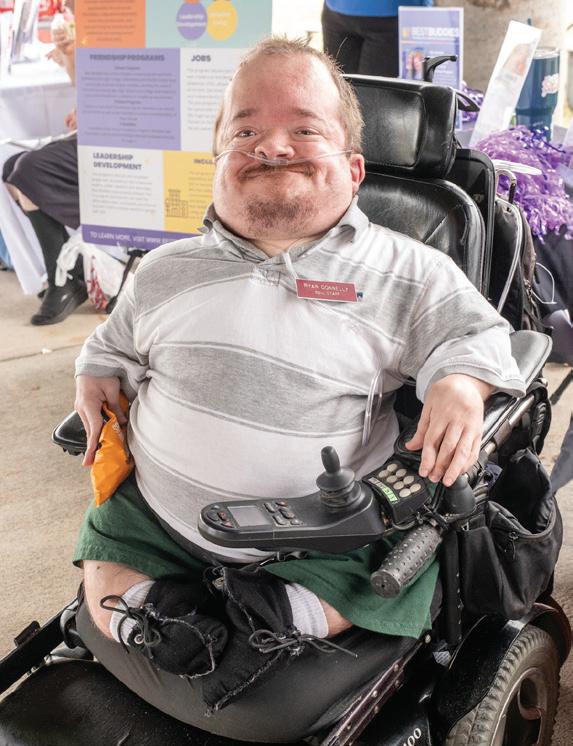
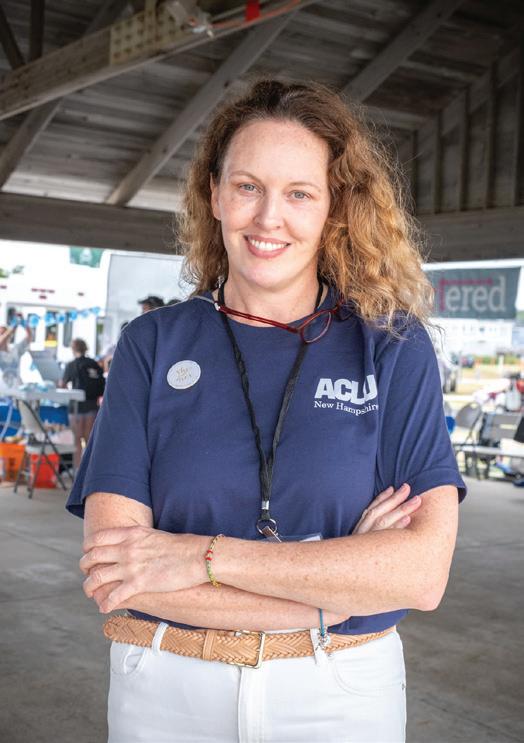
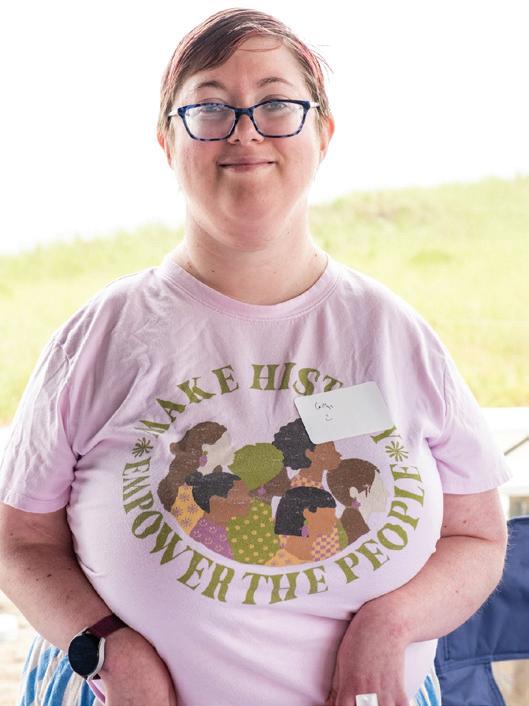

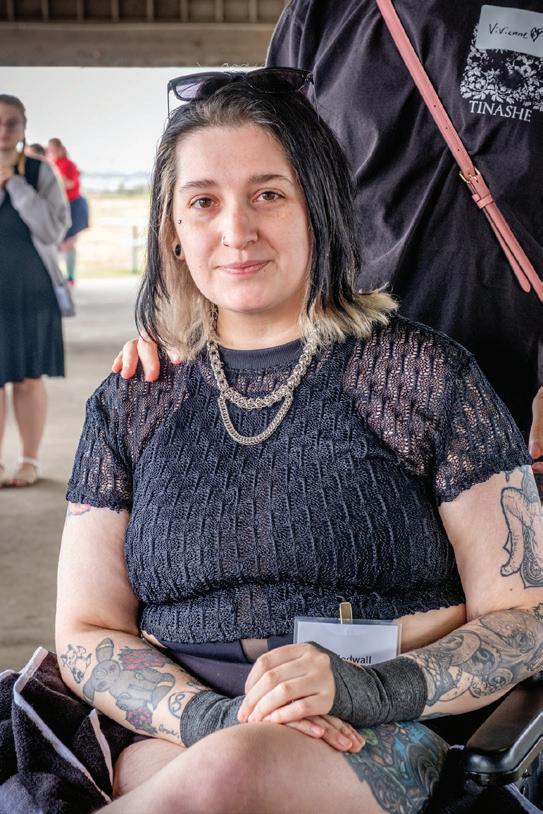

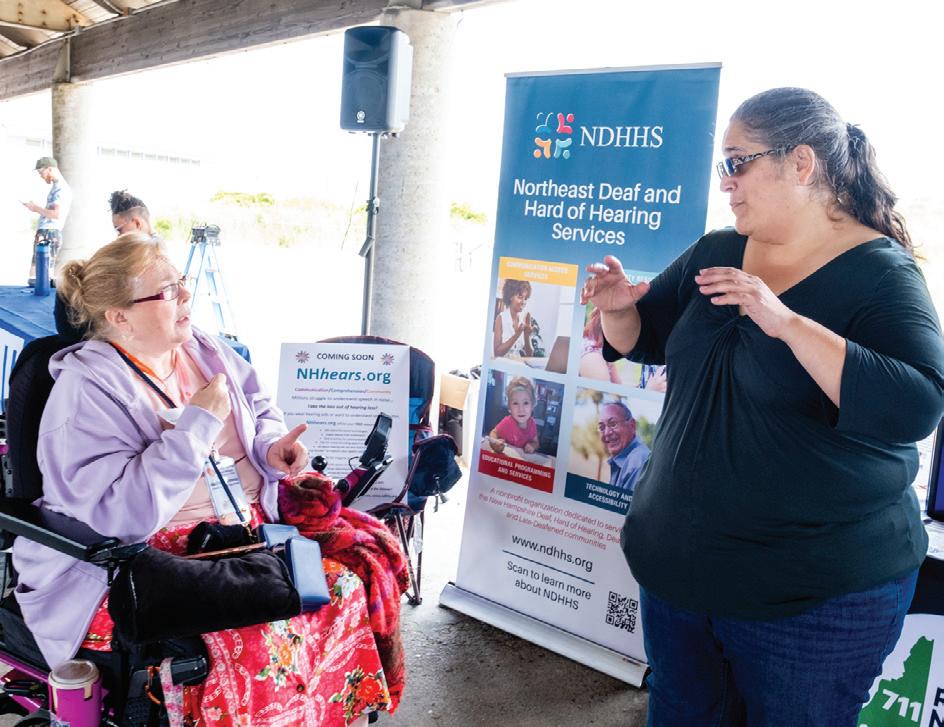
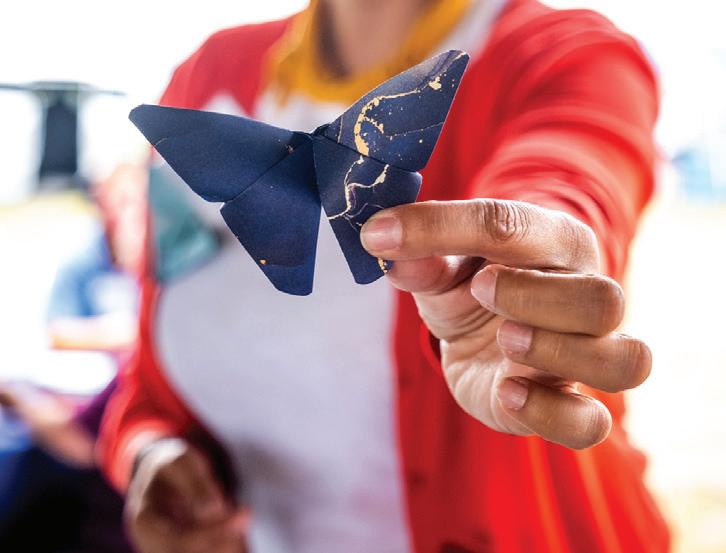
“Events like this and the Neuro Queer disability pride event I attended in Dover in July give me a sense of community and hope for the future,” Hedwall added.
“I’m so excited for this article to give this event the spotlight it deserves, and honored my voice can add a personal perspective as to why it is so important the world shifts its view of people with disabilities and start making real change towards a kind, accessible and inclusive future for everyone.”
Harake said she received encouraging positive feedback from the BeachAbility event.
“From the feedback I received, most organizations appreciated the fellowship, which fostered connections and sparked future collaboration,” she said.
“It raised awareness for barriers such as for the hard of hearing and visually impaired, as well as the incorporation of sister technologies to access nature. The event also facilitated direct dialogue with community leaders who showed up.”
In addition to music and art, visitors had the chance to experience various mobility aids on the sand, which they hadn’t done in years.
“One woman who was visiting the beach that morning stopped by and told me that her son, who was a quadriplegic and who

sign language with United Spinal Association’s Kristy Stellato; Rebecca Geekie from Birdability shows a paper bird; ACLU member and BeachAbility coordinator Katherine Harake; Ryan Donnelly, GSIL advocacy coordinator; Alan Roy, owner of “Able Trike Rack Systems.”
passed away recently, said that he would have loved to go to an event like this,” Harake said. “She then offered to volunteer for future events. Ky (Hedwall) also told me that they would love to attend future events and offered to help out any way they can.”
Given the positive response, many would like BeachAbility to become an annual event, and some even suggested a TrailAbility event in the fall.
“We all want to create an inclusive community for people with disabilities that ensures that they are valued and integrated members of society,” Harake said.” Equal access to New Hampshire’s beautiful nature is very important.” 603
With93 state parks and 679 walking trails throughout New Hampshire, there are plenty of ADA-accessible spots from which to choose. Visitors can plan their trip based on their needs and what support each park or trail offers.
For example, Ellacoya, Wellington and Pawtuckaway state parks offer beach wheelchairs, while Bear Brook State Park offers a power-driven mobility device (PDMD) called the Trackchair, an all-terrain wheelchair.
Franconia Notch State Park has 8 miles of paved recreational trails.
When researching locations, some supports to look out for include trails and walkways with hardened surfaces; ADA-accessible restrooms; showers and changing rooms with benches; viewing platforms; wheelchair ramps and reserved parking spaces. Each site is unique, so it’s best to call ahead or check online for the latest conditions.
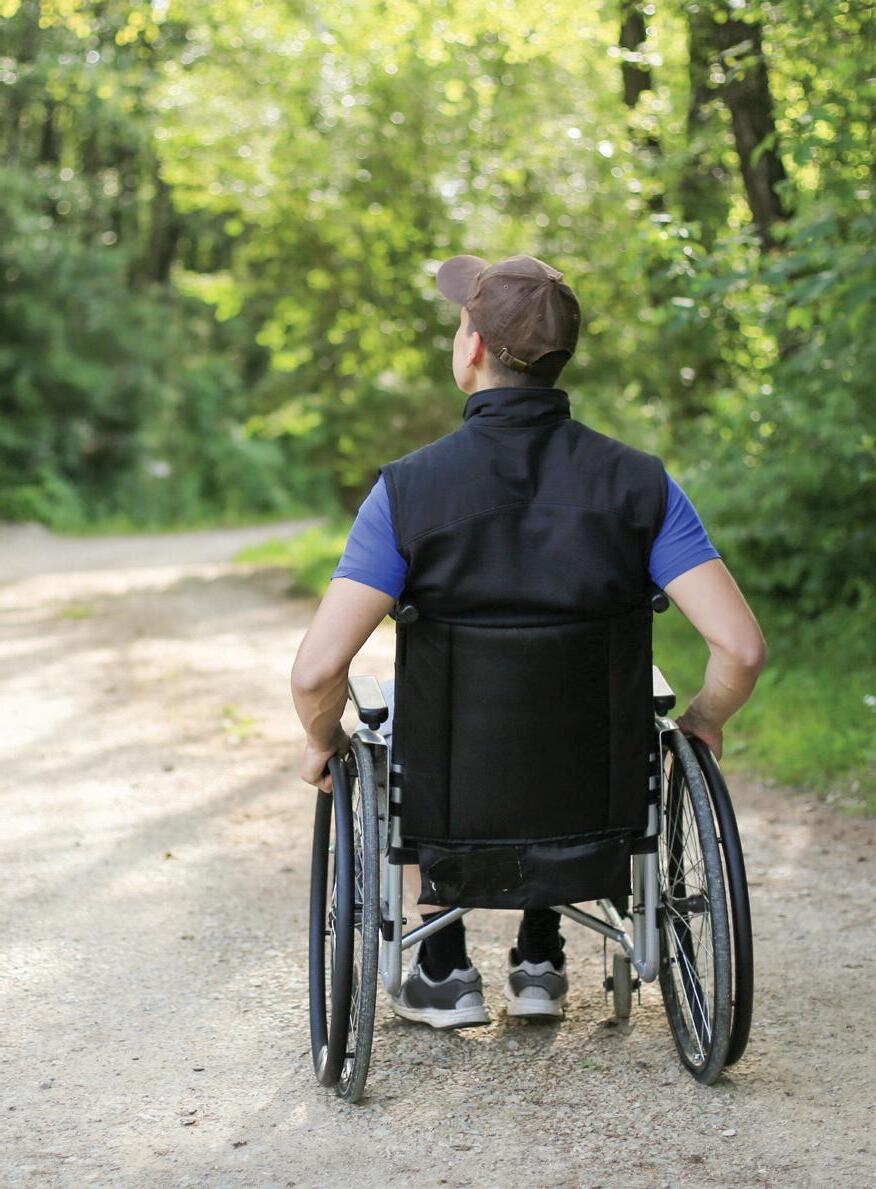
Several state parks have specific ADA-accessible information; for more details, visit nhstateparks.org. Contact nhparks@dncr.nh.gov, call 603-271-3556, or contact the park office directly.
Moose Brook State Park
30 Jimtown Road, Gorham: some flat gravel terrain; two accessible campsites near the restrooms
Ellacoya State Park
280 Scenic Drive, Gilford: Beach wheelchairs are available only when lifeguards are on duty.
Odiorne Point State Park
570 Ocean Blvd., Rye: paved recreational trail alongside Route 1A; natural surface network of trails; obstacles common but not “substantial.”
Cathedral Ledge State Park
579 Cathedral Ledge Road, Bartlett: Short walk to the parking area; a fully developed trail without obstacles; some ledges have moderate difficulty.
Jericho Mountain State Park
298 Jericho Lake Road, Berlin: Some ADA-accessible pathways; at least one campsite is accessible.
Bear Brook State Park
61 Deerfield Road, Allenstown: natural surface trails; one appointment day for trackchair; obstacles not substantial.
Franconia Notch State Park,
260 Tramway Drive, Franconia: Basin Cascade Trail, Franconia
Notch Path, Echo Lake Beach
Hampton Beach State Park
160 Ocean Blvd., Hampton
Wellington State Park
614 West Shore Road, Bristol
White Lake State Park
94 State Park Road, Tamworth
Kingston State Park
124 Main St., Kingston
Lodges at Coleman State Park, 1166 Diamond Pond Road, Stewartstown
Milan Hill State Park
72 Fire Tower Road, Milan
Mt. Sunapee State Park
86 Beach Access Road, Newbury
North Beach
920 Ocean Blvd., Hampton
Pawtuckaway State Park
128 Mountain Road, Nottingham
Umbagog Lake State Park
235 East Route 26 Cambridge, Errol
BY EMILY REILY

BY TRISHA NAIL / PHOTOS BY ROBERT ORTIZ

“When you get into a race car and you don’t have the use of four limbs to control that car, it takes even more talent and skill.”
— Danny Chrissanthis

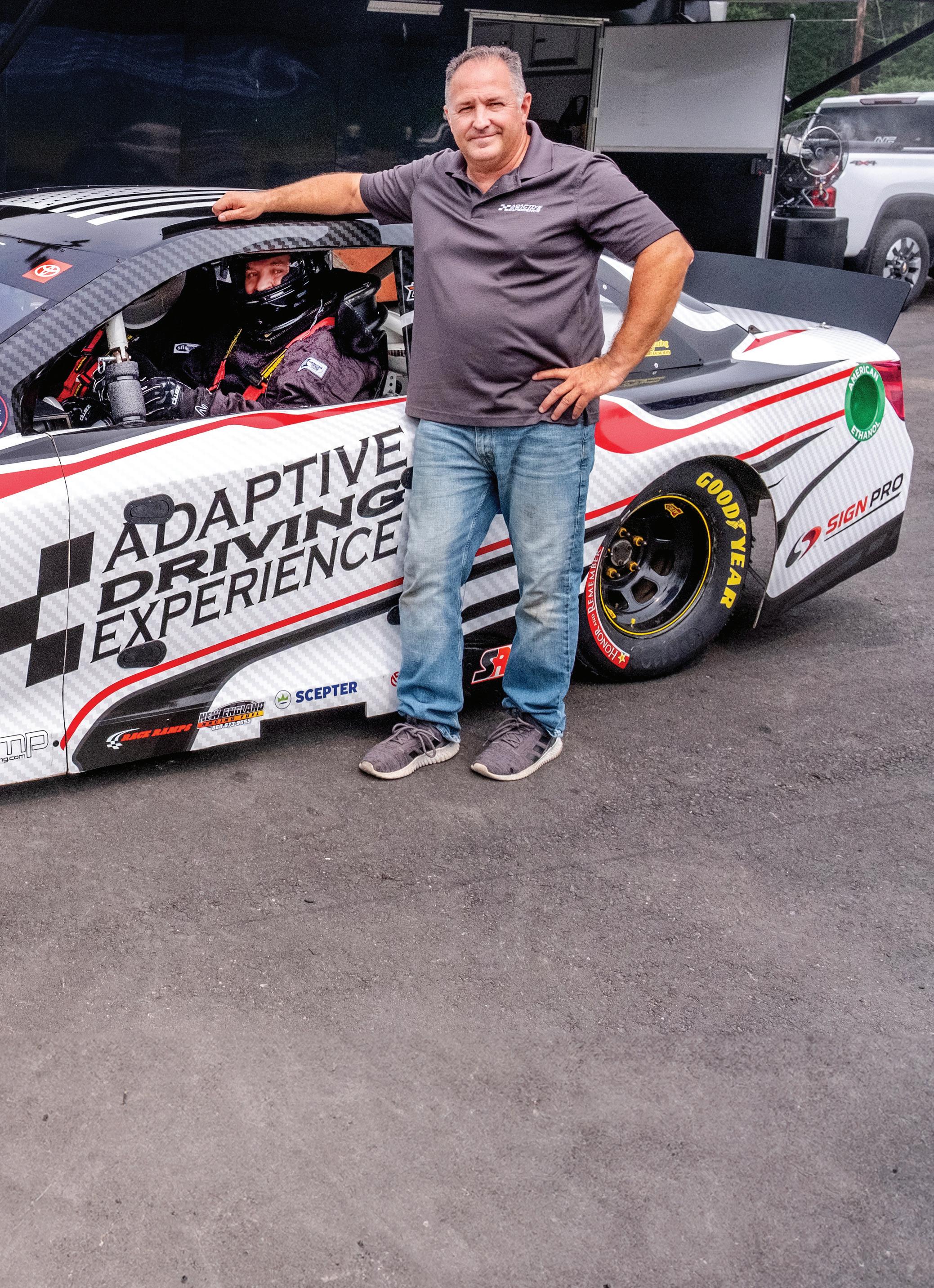
ABOVE: Director and designer Danny Chrissanthis from Derry, at right, with driver Robert Day from Waldoboro, Maine.
Derry resident Danny Chrissanthis doesn’t have a physical disability, nor did he know anyone with any such condition 12 years ago when he became involved with what’s now been an over-decade-long automotive project. But when the opportunity to build a race car that could accommodate disabled drivers or passengers presented itself, he took it.
Chrissanthis, the director of Adaptive Driving Experience (ADE), said it was a combination of extending his passion for stock car auto racing and seeking a “purpose in life” that motivated him and others to become part of the Derry-based nonprofit.
“This is what drives us,” he said. “I was able to be part of a few events that gave me a taste of what the end result is with these drivers who get to come in, not ever thinking they could get behind the wheel of a race car. That was, for many of them, the furthest thing in their minds.”
Continuing an earlier organization, ADE emerged when the first iteration’s founder left the project while Chrissanthis wanted to keep it going. Now under a mission to “offer inspiration, freedom and mobility with the use of a race car,” he and a core team of five other racing enthusiasts and technicians are working to get ADE’s first adapted car onto more speedways.
Using a 2014 Toyota Camry, referred to within the NASCAR sphere as a “Gen 6,” the ADE race car matches similar speeds to typical American stock cars but differs in that the steering column, gas and brake pedals are modified to have controls on both sides, with the primary driver on the right. Hand controls are added on the left, where a driver with a disability pushes or pulls the controls to perform the same functions as conventional pedals.
“Our push-pull hand brake is built by DriveMaster out of New Jersey,” Chrissanthis said. “They are the company that
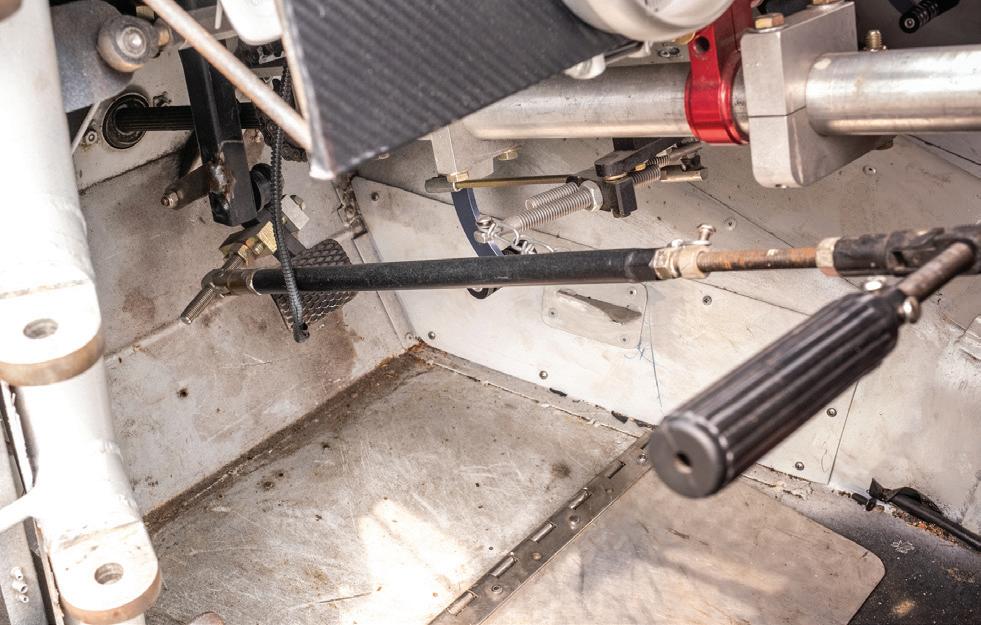
did a lot of the fabrication on our race car. The owner of that company, Peter Ruprecht, is our president.”
A passenger can sit on the left, where the normally sealed door in most stock cars can be opened for people with disabilities to get into the vehicle, and they’re able to access the hand controls if they want to do some of the driving.
Because of the unconventional seating position, the car also uses components of drag-racing vehicles to increase its safety, he said. Vehicles in NASCAR, for example, use the same left-hand driving as consumer American cars, but in stock car racing that becomes more important, since the right side of the car receives the impact in a crash.
That’s where Kevin Willey comes in. Willey, a police lieutenant then chief for a combined 14 years in Farmington, turned to worksite safety management after exiting law enforcement.
He and Chrissanthis met while working together for a con-

struction group with a branch in Epsom, during which time Willey became ADE’s safety director. He’s helped develop safety protocols and trained people on how to operate the organization’s race car.
“All of our drivers, before they get in the car, are put through a safety briefing,” Willey said. The briefing includes checks on safety equipment; the steering column and wheel; proper seatbelt restraint; comfort of the occupants; and a review of the vehicle’s body and tires.
“When you’re talking about somebody that may have some sort of physical limitations, then it’s really important to explain to them what to do in the case of a crash or fire.”
Then, before taking a passenger with disabilities onto the racetrack, a driver performs hot laps: complete timed practice laps around the track as a final live test.
“I think a ton of credit goes to our drivers, because both of them have backgrounds in racing, but we’re putting them on the opposite side of the car, and everything they do feels differently than when they get in the car,” said Willey, who himself has raced in stock cars, including the ADE car.
A New Hampshire car builder assembled the vehicle, and Ruprecht and the team at DriveMaster installed the adaptive modifications, Chrissanthis added. In total, he estimates manufacturing

and developing the car cost between $75,000-$100,000 including labor fabrication costs, but most of the vehicle — like the engine, drivetrain, wheels and seats — was donated to ADE. As a nonprofit, the organization also raised about $25,000 for other necessary, miscellaneous parts.
The base car itself before modifications was bought out of pocket, but Chrissanthis expressed that it’s all worth it to him and the ADE team due to the nature of the project.
“We can take folks with a variety of disabilities, whether they’re amputees, paraplegic or quadriplegic,” Chrissanthis said. “You could even take somebody who was blind.”
Chrissanthis recalled meeting Matt Stutzman, a 42-year-old drag racer born without arms who drives vehicles solely using his legs and feet. Stutzman is better known for his archery, recently winning gold at the 2024 Paralympics in Paris.
“When you meet people like that, you realize there are some folks stepping up to a whole other level as far as what they’re capable of doing and willing to do,” Chrissanthis said. “They are truly the inspiration for me.”
Locally, Chrissanthis and his project team welcomed Granite Staters with disabilities to Epping’s Star Speedway on Aug. 15 for a demonstration event to share their impressions of riding in the car. Inclement weather prevented the ADE team from holding a full
afternoon of racing demos, but Chrissanthis said those who managed to try out the car gave it the green light.
“A gentleman who came from Maine, Bobby Day, wasn’t even told he was driving a race car,” he said. “It’s something we planned six weeks before this took place; he’s a huge racing fan. When he pulled into (Star) and we said, ‘Dude, you’re about to drive that car,’ he was pretty excited.”
More positive reception that day came from Dave Martin, 75, of Hampton Beach, the father-in-law of ADE board member Sean McLaughlin and one of the drivers. The other is ADE Vice President Scott Vien, who doubles as a driving instructor for the vehicle.
Martin, a veteran who served in the U.S. Navy from 1968-1972, is an amputee who lost his right leg, but not during his time in Vietnam. Rather, the loss was in 2018 after he faced a triple aneurysm and subsequent repair that cut off circulation to his foot and lower

leg before Martin made the call to have his lower leg up to his knee removed. He now uses a prosthetic replacement for full mobility, but that did not impede his test drive at Star Speedway.
“It was comfortable, or as comfortable as it could be,” Martin said. “Usually when I’m riding or driving, I will take my prosthetic off my right leg, so I had them do that. The fire suits we were required to wear were brand new to me, so it was a little awkward. But all in all, I really enjoyed it — it was rattling me to my core driving around in that.”
His bigger takeaway from the experience was a sense of admiration and new respect for career NASCAR drivers after he tried just 15 laps around the track.
“They’re athletes to be able to go around these tracks 300-400 times,” Martin said. “You get a real appreciation of how well they’re put together.”
As far as bringing a vehicle like ADE’s car to the professional circuit goes, Chrissanthis says it’s likely not a realistic goal at this stage, but he did note that its chassis was designed by NASCAR engineers, and the nonprofit worked with an industry consultant linked to NASCAR to ensure a safe design.
Instead, Chrissanthis envisions the adapted vehicle on road courses and offering more test drives on days that professional races are held at New Hampshire Motor Speedway in Loudon to spread awareness of the nonprofit and its capabilities.
He also longs to bring a second car into the fold. That, he says,
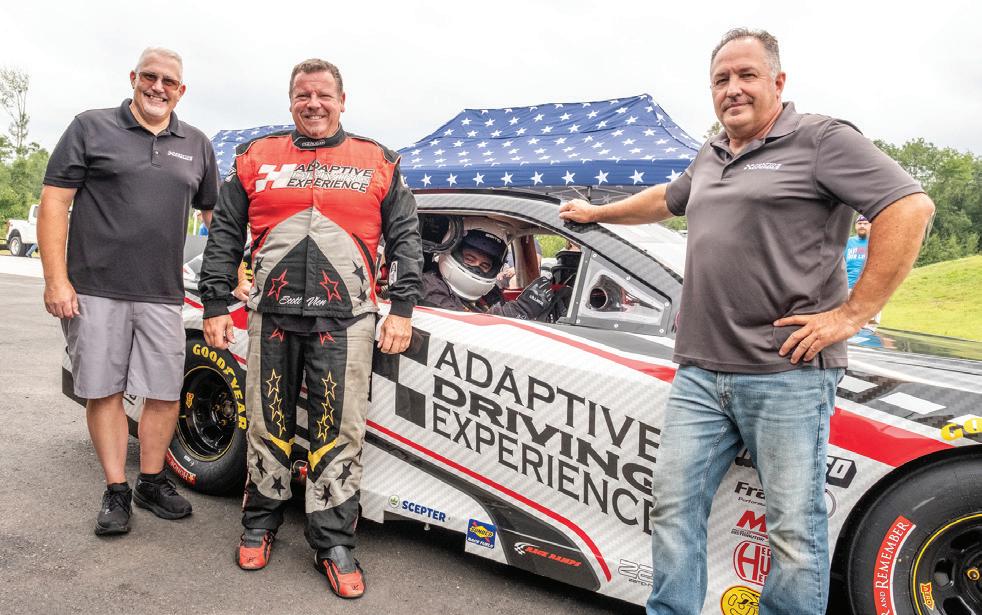
would continue ADE’s work, expand marketing opportunities and allow for a backup vehicle in case the other has a mechanical failure. It may also give ADE the chance to modify a Chevrolet or Ford to entice drivers more accustomed to cars from those manufacturers.
But that “all comes down to funding,” Chrissanthis notes, being a nonprofit.
“I feel like we’re building momentum and are on a roll here, and that we’ll hopefully start to attract some corporate sponsorship, some grants or people who want to get involved so we can make this organization grow,” Chrissanthis said. “Having someone more knowledgeable in nonprofits that can help with grant writing or fundraising (could help) grow the team.”
For now, Chrissanthis is proud of the work he and his ADE colleagues have achieved, and they intend to continue exhibiting their adapted race car at regional and industry car shows at Indy and in New England, company gatherings and whatever other events present
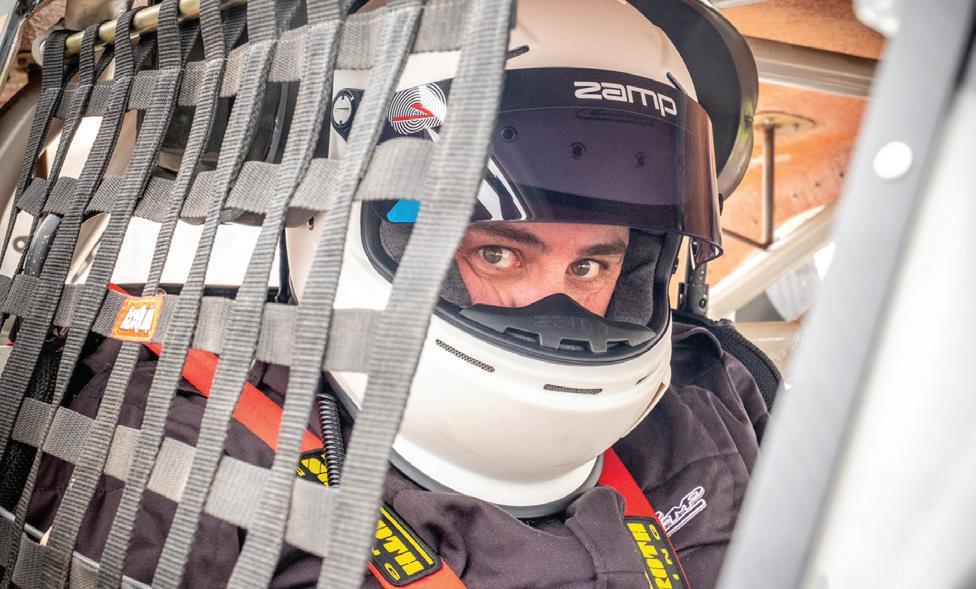
Instructor Shawn Viens sits on the passenger side of the car and has his own set of controls, including a steering column.
themselves. But Chrissanthis remains prouder of those who demonstrate the vehicle’s ambitious function.
“A lot of people like to use the term ‘abilities’ as opposed to ‘disabilities,’ ” he said. “We know people that are doing extraordinary things without the use of an able body like we take for granted most of the time.
“When you get into a race car and you don’t have the use of four limbs to control that car, it takes even more talent and skill.” 603
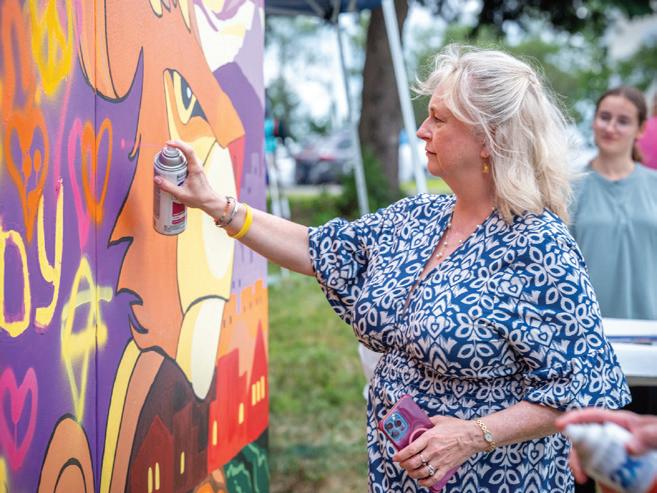



BY SARAH PEARSON
PHOTOS BY ROBERT ORTIZ
In 2018, Rabbi Berel Slavaticki and his wife, Rochy, moved from New York, where there was a large Jewish population, to Durham, New Hampshire.
“We were looking for a place that the Jewish community could use some growth and potential,” Slavaticki says.
Their goal was to offer Jewish education and programs in an area where it was lacking.
“When we moved here, people were like, ‘What? There’s no potential there. There’s no hope here. There are no Jews here,’” he

says. “And we felt like there were. We made our research, and we knew that there’s a nice community. Maybe not a lot of Jewish people that are noticeable on the outside, but a lot of Jewish people that are looking for more connection.”
In the past six years, they have found and fostered those connections.
“We started small, but then the demand grew and grew,” Slavaticki says.
What began with Jewish student outreach at the University of New Hampshire, has now outgrown two different storefronts and purchased a campus in Newington where they run the Seacoast Chabad Jewish Center.
Slavaticki was born in Belgium and worked on his rabbinical studies in Belgium, Israel, Maryland, Michigan and New York. He’s taught and led services in several countries and multiple U.S. states. Rochy Slavaticki was born in New York

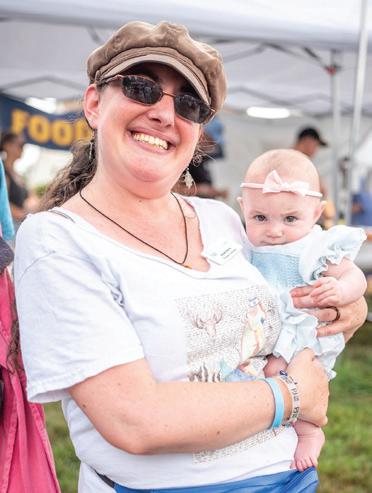
and earned a degree in special education.
The center offers weekly Shabbat and Kiddush services, a women’s circle, a teen group, Mentch Club and other programs.
A Hebrew school that started two years ago with two children now has 40 students. They also have adult educational programs.
Seacoast Chabad is also involved in charitable work, including giving away donations of backpacks of school supplies to students in need, and a weekly meal program.
In July, the center opened an on-site kosher bakery, The Brooklyn Café.
“When you think about a kosher cafe or kosher places, you usually think about the larger cities: Boston, New York. They have larger Jewish communities,” Slavaticki says. “But our vision was to try to create something, which is kosher, obviously, but to make it appealing and desirable





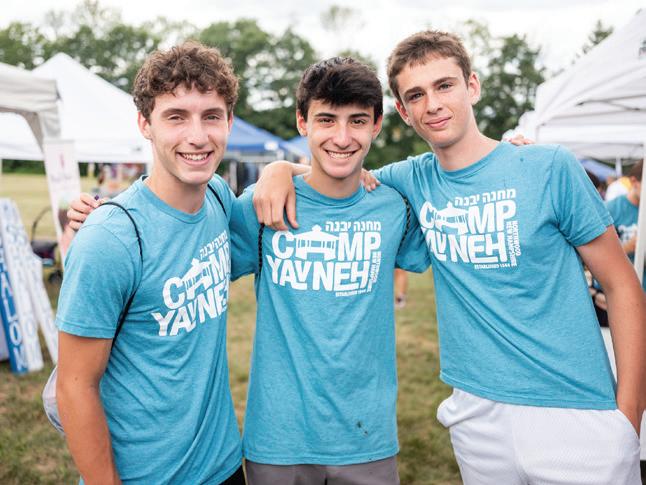

to all the wider community.”
The bakery offers bagels, pastries, meat-free pizzas, falafel, fries and drinks including soda, coffee and tea.
While it was important that the café was kosher to serve Jewish people, Slavaticki says, they also wanted items and an atmosphere that would bring in customers from the wider community so it’s sustainable.
“People are excited about the food, obviously,” he says. “It’s beautiful to see that, maybe, I would say 85% to 90% of the people that are coming in are actually not Jewish people.”
days, there will be a place that we can have. People won’t have to go to Boston anymore.”
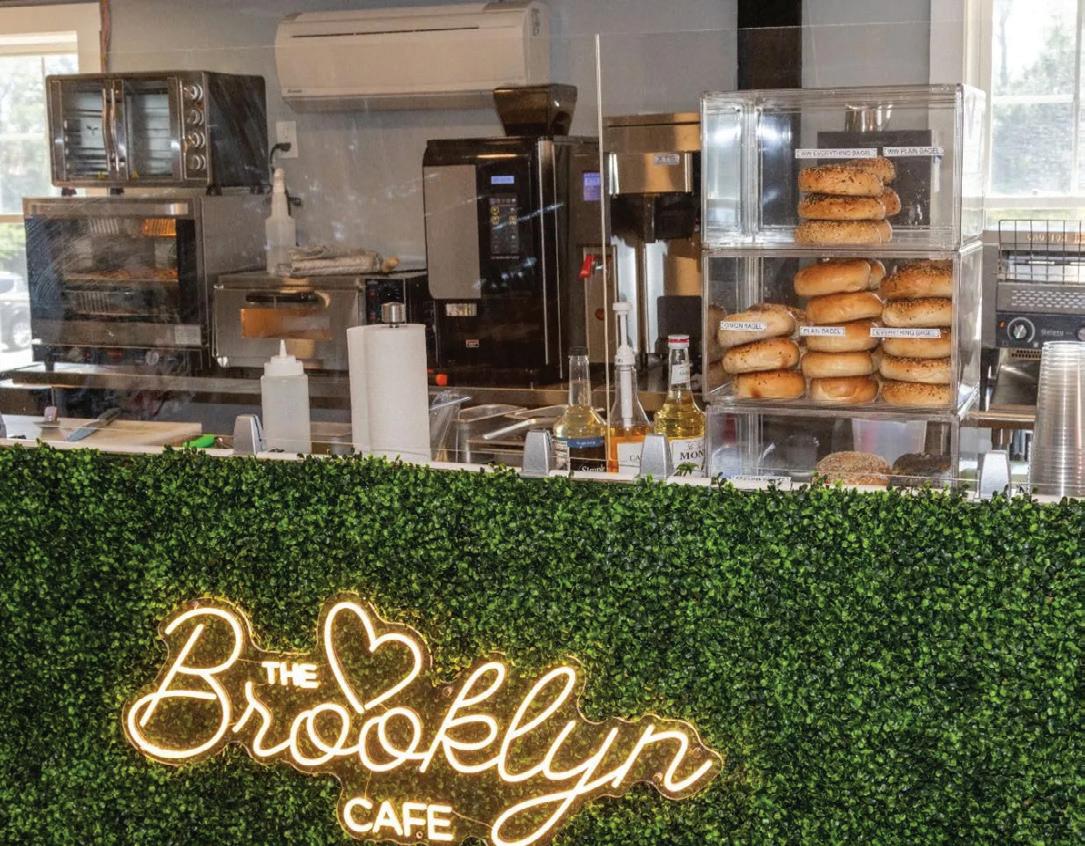
The cafe is a resource for the Jewish community to access cultural foods.
“Food is a big part of religion,” Slavaticki says. “It’s very good that we have a place now for people to get the customary things like challah bread. Come Hanukkah, Purim or other Jewish holi-

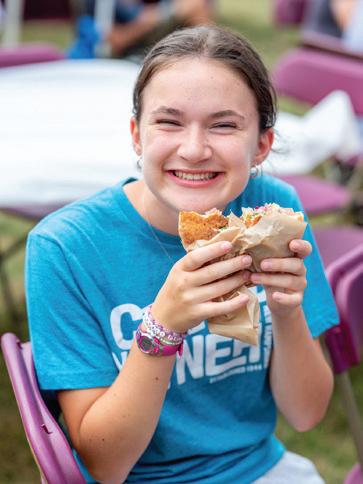
The Brooklyn Café is set up as a nonprofit, with the proceeds going to locals in need. It’s been so popular, Slavaticki says he’s already been getting requests for a Jewish deli, since meat products need to be handled separately from food that contains dairy in the Jewish religious tradition.
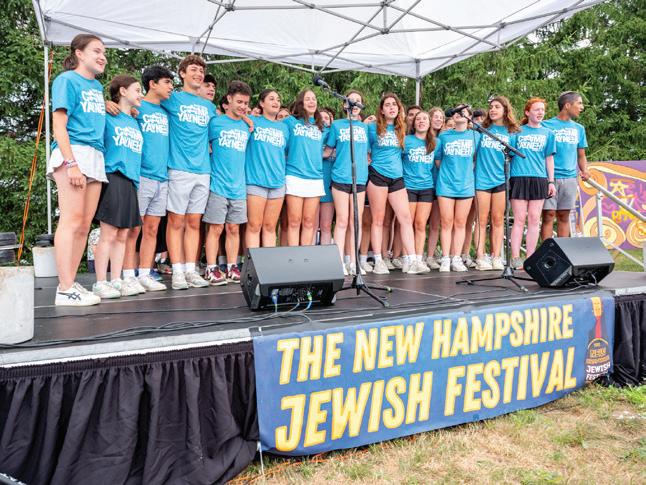
Just a few weeks after the bakery opened, Seacoast Chabad hosted the third annual New Hampshire Jewish Festival. The festival had vendors, food, games and activities, plus an array of entertainment. Moshe Reuven, a Billboard-charting singer, Noam Agami and the Klezmer Conservatory Band performed. Campers from Camp Yavneh in Northwood were also invited to participate.
“We wanted to get some young people to help add atmosphere,” Slavaticki says, “to make it more exciting.”
A goal to connect the Seacoast Jewish community has become a reality, with a growing campus and community outreach.
“Most people that are coming out to the Jewish Center, they don’t believe that this is actually happening,” Slavaticki says. “They thought it would never happen.” 603

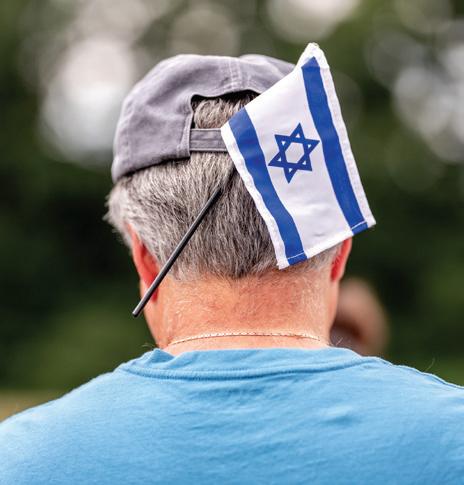
A journalistic look at our state of diversity from the reporters at the Granite State News Collaborative.
603 Legal Aid and Shaheen & Gordon, P.A., announced in October that they have partnered to launch the 603 Name Change Project. This initiative will provide free legal name change services to low-income members of the LGBTQ+ community and others who may seek to change their name for safety reasons.
Participants may apply to the project through 603 Legal Aid’s intake process. Once their eligibility is confirmed, they will be paired with an attorney from Shaheen & Gordon who will guide them through the name change process in a safe and welcoming environment.
“Everyone deserves to have their legal name match their identity. We’re honored to partner with 603 Legal Aid to provide these services to those who do not have the means to hire an attorney,” says Lyndsay Robinson, a partner at Shaheen & Gordon and co-chair of the firm’s Diversity, Equity, and Inclusion Committee.
“603 Legal Aid’s mission is to help make access to justice a reality for Granite Staters who experience economic hardship,” says Emma Sisti, deputy director of 603 Legal Aid. Applicants must be 18+ and meet 603 Legal Aid’s income and asset eligibility requirements to qualify. People are invited to visit 603legalaid.org or call 603-224-3333 to learn more.
— PAIGE MOULTON,
Across New Hampshire schools, the answer to “what’s for lunch?” varies widely, based on students’ ability to pay for meals, and their school district’s policy for what happens when they can’t.
At Stratford Public School in North Stratford, all students in kindergarten through eighth grade have access to free meals, thanks to a provision in federal funding that only three schools in New Hampshire currently use.
“Families appreciated knowing their children would have access to meals at school without needing to apply for free or reduced-price lunch programs,” said principal Allison Noel.
Yet in Keene and other towns in its school administrative unit, students as young as sixth graders can be refused a lunch if they’ve acquired debt and don’t have cash in hand. Younger students with debt are directed to a sandwich, rather than the warm main entree.
“It sounds hardcore, but ... there’s got to be a cutoff,” said Tim Ruehr, chief financial officer in SAU 29, which includes Keene.
While Stratford and Keene are extreme examples, they’re not alone in trying to set policies to handle debt created when students don’t pay for their meals. The Concord School District had $93,000 in outstanding meal debt at the end of the last school year, while officials in Goffstown and New Boston recently reversed a decision to sue families that had outstanding meal debt.
Maine, Vermont and Massachusetts have all adopted universal free school meal programs. Research shows these programs can bolster health, reduce childhood obesity and improve academic outcomes.
Advocates say there are policy solutions, including using Medicaid data to qualify students for free or reduced-price lunch, improving access to online applications for the program, and increasing income limits for free and reduced-price lunch.
Ultimately, they say, allowing kids better access to food and reducing school meal debt is an equity issue.
— KELLY BURCH, GRANITE STATE NEWS COLLABORATIVE




When new state restrictions on trans athletes took effect in August, Maëlle Jacques was nervous.
Jacques, who is trans and just started her junior year, has been a goalie on the girls’ varsity soccer team at Kearsarge Regional High School since last season. She’s been playing soccer since she was 3 years old, and has made many close friends on the field.
“The team environment in soccer is something special,” she said.
Heading into this season, Jacques knew she might be forced onto the sidelines — she had testified in the State House against proposed laws that would ban her from playing on the girls’ team. When Gov. Chris Sununu signed one of those laws this summer, she still continued practicing and conditioning as usual. But one day, she received the news she had been dreading.
Kearsarge, like many other New Hampshire school districts, found itself in a bind, as state officials urged schools to enforce the ban while some attorneys argued it could violate federal law.
The families of two other trans girls sued the state in August before Jacques’ preseason began. They claimed the law violated federal civil rights protections, and the judge issued a temporary restraining order allowing one of those athletes to play. But as that case worked its way through the courts, Jacques had to sit on the bench, still attending all of her team’s practices and games but unable to participate herself.
At the end of August, Jacques appealed directly to her school board to ask for permission to rejoin the team. She relied on the legal arguments outlined in the ongoing court case, arguing that New Hampshire’s new sports ban violates federal Title IX measures. She wrote her remarks between classes, getting some tips from her older brother and an ACLU lawyer.
After more public testimony and nearly 40 minutes of deliberation, the board announced their decision: Jacques could return to the girls’ team. She said she felt “elated” when she heard the news.
“The first thing I did was I messaged my team’s captains who had been asking me every day when I was going to be back,” Jacques said. “And I mean, obviously they were very excited as well.”
— KATE DARIO, NH PUBLIC RADIO
Batulo Mohamed’s Somali food opened Concord’s culinary horizons. Susan Chung hopes her Korean kimbap will widen them a little more.
In August, Chung, the second chef in the Capitol Center for the Arts Culinary Artist in Residence program, will start selling kimbap, a traditional Korean rice roll, to the masses.
For Salvatore Prizio, executive director at the center, the test kitchen concept touches on the heart of his mission to benefit both the community and artists of all sorts.
“The best way to break down boundaries between communities is with food and arts,” said Prizio.
Prizio instituted the center’s Culinary Artist in Residence program at the tail end of 2022 with inaugural chef Mohamed, whose Somali food drew a following in Concord. In just over 18 months, Mohamed’s sambusas — traditional Somali meat pies — earned her enough money to turn Batulo’s Kitchen into an independent food truck and catering business, which opened the kitchens at the center’s two venues to another cuisine.
With her husband and their two teenage sons, Chung hopes that Sue’s Kimbap House will introduce a Korean cultural staple to Concord with the same success that Batulo’s Kitchen saw.
Kimbap is quite self-explanatory — “kim” in Korean means “seaweed,” and “bap” means “rice.” The soft seaweed encases white rice, which Chung presses around a variety of Korean ingredients. Her signature dish features a spiced beef called bulgogi, with carrots, spinach, pickled radish, egg and imitation crab. She uses the same ingredients — except the bulgogi — in her spam roll, which has been supremely popular among friends and family as she tests her recipes. Kimbap is meant to be eaten in one bite, like a piece of sushi, so all the flavors arrive together, though that’s a tall task for Chung’s thick pieces.
Sue’s Kimbap House will be open Tuesday through Sunday, 11 a.m. to 6 p.m., and later when there are performances at the Bank of New Hampshire Stage. — SOPHIE LEVENSON, CONCORD MONITOR

These articles are being shared by partners in The Granite State News Collaborative. For more information, visit collaborativenh.org.
New England’s largest independent Center-of-the-Plate Distributor is providing an environment focused on career growth, employee development, and recognition.
DEDICATED to diversity and inclusivity, promoting a welcoming and rewarding work environment for all employees.
COLLABORATIVE and supportive culture fostering team building with organized company outings, activities, and celebrations.
COMMITTED to employee work-life balance with competitive benefits, time off, and an Employee Assistance Program.

IF YOU BELIEVE OUR COMPANY’S CULTURE AND VALUES ALIGN WITH YOUR CAREER GOALS, WE ENCOURAGE YOU TO APPLY TODAY!



BY JAMES MCKIM
Most of you know me as a champion of inclusion and equity from organizational and societal perspectives. But my background is in technology, and I have become increasingly interested in exposing where technology is failing not only the able-bodied but also the disabled. Let’s face it: We could all be disabled in one way or another someday.
In our increasingly digital world, technology plays a pivotal role in shaping how we live, work and interact. However, a concerning trend has emerged: Many technologies, both AI-powered and non-AI, exhibit biases against people with disabilities. This bias not only perpetuates existing inequalities but creates new barriers to inclusion and accessibility. As we continue to innovate, it’s crucial to address these biases and create technologies that truly serve all members of society.
Recent studies reveal significant biases against people with disabilities in AI and machinelearning models. For instance, research from Penn State University shows that popular AI models exhibit explicit bias against disability-related terms in sentiment analysis and toxicity detection tasks.
However, the issue of bias extends beyond AI to many other forms of technology. User interfaces, hardware designs, websites and mobile applications often fail to consider the needs of users with various disabilities, creating significant accessibility barriers. These biases manifest in multiple ways: 1. Inaccessible digital interfaces that exclude users with visual, auditory or motor impairments.
2. Physical devices lacking inclusive design features. 3. Websites failing to meet accessibility standards. 4. Mobile apps without proper accessibility features.
Understanding the root causes of these biases is crucial for developing effective solutions. Some key factors contributing to technology bias include:
1. Lack of representation: Development teams often lack diverse perspectives, including those of
people with disabilities. It’s like trying to bake a cake without flour.
2. Insufficient testing: Products may not be adequately tested with users who have disabilities.
3. Narrow design focus: Designers and developers may operate on limited definitions of disability or fail to consider the full spectrum of user needs. It’s like designing a one-size-fits-all sweater for a group of people with different body shapes.
4. Cost considerations: Accessibility features are sometimes viewed as expensive add-ons rather than essential components.
The impact of these biases can be far-reaching and severely detrimental to people with disabilities:
1. Employment discrimination: AI-powered hiring tools and inaccessible job application systems may unfairly disadvantage candidates with disabilities.
2. Educational barriers: Students with disabilities may struggle with inaccessible learning management systems or digital textbooks.
3. Social exclusion: Biased content moderation systems and inaccessible social media platforms can isolate individuals with disabilities.
4. Health care disparities: Medical devices and health information systems that aren’t universally designed can lead to inadequate care.
Addressing these biases requires a multifaceted approach that encompasses both AI and non-AI technologies:
1. Inclusive design principles: Adopt universal design principles from the outset of product development to create technologies usable by all people to the greatest extent possible.
2. Diverse team composition: Include people with disabilities in technology development teams and decision-making processes to bring diverse perspectives to the table.
3. Comprehensive user testing: Implement rigorous testing protocols that include users with various disabilities to identify and address potential issues early in the development process.
4. Adherence to accessibility standards: Follow established accessibility guidelines, such as the Web Content Accessibility Guidelines (WCAG) for web content, across all digital products. Think of it as the “rules of the road” for the internet — everyone should know where to go.
5. Adaptive technologies: Develop and promote technologies that can be easily customized to meet diverse user needs.
6. Education and training: Provide disability awareness and inclusive design training for technology professionals to raise awareness of potential biases and accessibility issues.
7. Legal and policy frameworks: Strengthen and enforce regulations requiring accessibility in technology products and services to ensure compliance and accountability.
8. Funding initiatives: Allocate resources specifically for developing accessible technologies and retrofitting existing ones to prioritize inclusivity.
9. Bias detection and mitigation in AI: Implement rigorous testing protocols to identify and address biases in AI models, particularly in areas like natural language processing and computer vision.
10.Transparency and accountability: Implement clear reporting mechanisms for algorithmic impact assessments and mitigation efforts to foster trust and enable continuous improvement.
While challenges remain, there are encouraging examples of non-AI technologies that have successfully mitigated bias:
1. Blind auditions in orchestras: The
use of screens to conceal candidates’ identities during auditions has significantly increased the proportion of women hired by major symphony orchestras.
2. Anonymous resume-screening software: Tools that remove identifying information from resumes before human review have helped reduce unconscious bias in initial candidate screening for jobs.
3. Standardized testing accommodations: Technologies like screen readers and speech-to-text software have made standardized tests more accessible to people with disabilities. Because everyone deserves a fair shot.
4. Closed captioning and audio description: These technologies have improved media accessibility for people with hearing or visual impairments. Now everyone can enjoy the latest film.
5. Adjustable workstations: Height-adjustable desks and ergonomic equipment accommodate a wider range of body types and physical abilities in the workplace.
As technology continues to shape our world, it is crucial to address biases against people with disabilities across all forms of technology, both AI and non-AI. By implementing comprehensive solutions and maintaining a commitment to inclusivity, we can work towards creating a technological landscape that truly serves all members of society. The goal should be to harness the power of innovation to enhance accessibility and equal opportunity, rather than perpetuate existing barriers. Through collaborative efforts involving technologists, policymakers, disability advocates, and users, we can build a more inclusive digital future for everyone. After all, a world where everyone can participate is a world worth creating. 603

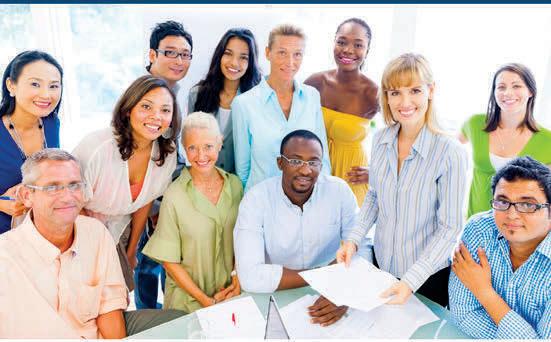

BY VANESSA WEATHERS
Community leadership is vital for creating spaces where individuals feel recognized, supported and empowered to flourish.
Black Womxn in New Hampshire (BWINH) Inc. plays a crucial role in nurturing leadership by providing a haven for Black women, who are often excluded from conventional leadership pathways. With a mission to mitigate the effects of racism, sexism and gender discrimination, BWINH Inc. serves the Black community in New Hampshire and neighboring states. I want to share the inspiring journeys of three collective members who have faced significant challenges and are now community leaders.
The phrase “imposter syndrome” is commonly used to describe the experiences of Black women in professional settings. However, this term conceals something far more harmful: the systemic exclusion intentionally designed to prevent Black women from succeeding. Rather than addressing the structural barriers that exist, “imposter syndrome” shifts responsibility onto the victim, implying that they alone must conquer these obstacles. BWINH Inc. acknowledges that the issue extends beyond personal doubt; it is embedded in oppressive systems that seek to disempower and exclude.
At BWINH Inc., we endeavor to cultivate an environment where Black women can access their innate and ancestral leadership skills without feeling the need to conform or diminish themselves. The collective provides a platform for Black women to lead authentically, without the limitations of exclusionary standards. These three BWINH members showcase how the organization helped them embrace their full leadership potential without compromise.
Deb, originally from Pittsburgh, Pennsylvania, relocated to Maryland as a child, where she was raised by both parents despite their divorce.
She faced challenges as one of only two Black students in her school. Though she didn’t fully grasp the significance of these experiences at the time, her move to Maryland presented new perspectives. There, her Black peers would sometimes question why she “sounded so white” or had “proper grammar.” While these remarks occasionally hurt her, Deb learned to overlook such comments, particularly in her personal life.
Deb discovered BWINH Inc. in 2023 after a friend tagged her in a group post. Having lived in New Hampshire for 13 years, where diversity is limited, she was thrilled to find a collective for Black individuals. Eager to contribute her strengths to the group, Deb became more involved, organizing monthly meetups and fostering community connections. Her work helps cultivate trust and unity among members, and she envisions BWINH Inc. continuing to grow, providing a safe, respected and loving space for Black women.
Jacquai Heyward was born in Fitchburg, Massachusetts, and moved to Hudson, New Hampshire, as a baby. She currently lives in Merrimack. Growing up in a predominantly white environment, Jacquai’s identity as a Black woman strengthened her commitment to racial justice and Black empowerment. Passionate about advocating for Black rights, she sought community work that aligned with her values. Jacquai joined BWINH Inc. because of its alignment with her pro-Black stance. Today, she serves as the programs and activities chair, overseeing event planning and sharing creative ideas with her team. Throughout her life, Jacquai felt the need to work harder than others to gain recognition, believing that as a Black woman, she had to constantly outperform her peers. BWINH Inc. helped her confront these pressures, building her confidence as a community leader. One of
her proudest moments was organizing the Juneteenth celebration, an event that brought the Black community together to commemorate emancipation. Inspired by Dwyane Wade’s quote, “My belief is stronger than your doubt,” Jacquai is determined to continue growing as a leader, even if it’s a long hard battle.
Theresa, from Detroit, Michigan, grew up in a family with deep Southern roots, shaped by Sunday gatherings around homemade Southern meals. These experiences instilled values of togetherness and resilience, which have influenced Theresa’s dedication to building strong community networks.
Theresa’s passion for community work stems from her desire to create a village for her children and other families seeking support. She joined BWINH Inc. to build a strong network where families can access resources and feel supported. As part of the Communications and Marketing Committee, Theresa focuses on connecting with the community and amplifying the organization’s initiatives. One of her most memorable experiences was co-hosting the Juneteenth celebration and serving as a vendor through her business, BreakingBread603. This event deepened her commitment to creating spaces where the Black community can celebrate their heritage.
These stories highlight the profound impact BWINH Inc. has on its members, helping them overcome systemic barriers and grow as leaders. By providing a safe space for Black women to lead authentically, BWINH Inc. fosters the resilience needed for lasting change. Readers can support BWINH Inc. by following the collective on social media and sharing information about it with Black women in their networks. 603

*Conditions apply. Contact your local college today. The Promise Program bridges the gap between grants and scholarships and the cost of tuition, enabling eligible students to attend any one of NH’s seven community colleges tuition-free.*



BY ALBERTO RAMOS
Our country is deeply divided, and an election season can reveal how deep those divides truly are — or seem to be. Sometimes the differences that separate us are skin deep; other times they are ideals that define the core of our identities. And we’ve become good at avoiding hard subjects, because talking about them can make the divides seem worse.
At Plymouth State University’s IDEA (Inclusion, Diversity, Equity and Access) Center, we’ve discovered that talking about difficult or controversial topics can be healing when done with mutual respect, and when we share and listen to personal stories.
After attending a recent Interfaith Leadership Summit on “Building Bridges in Higher Education” to cultivate pluralism in the classroom, Assistant Director of the IDEA Center Paige Paradise helped to create a new group learning session offered by the center’s Diversity Education program called “Building Bridges Across Deep Divides.” It uses the power of personal storytelling to get beyond opposing opinions, heated debates and ad hominem attacks, and instead focus on the reasons we feel the way we feel and the things that make us all human.
How it works: Participants begin the sessions establishing “shared community values.” Doing this helps keep the conversation from veering too far off course by setting expectations that everyone agrees to respect. These community values often include the importance of creating a welcoming environment, remaining engaged, speaking and listening, confidentiality, curiosity, embracing growth from discomfort, owning your own truth, humility, and self-awareness. The community values can be individualized to suit each group.
After values are set, we engage in a listening activity, which is a test to see how good we all are at effective listening; it typically involves going around the room and asking participants a question regarding a memory, a favorite meal or a reason why participants made a certain life choice. This simple activity allows participants to practice active listening and storytelling. It also usually reveals, when we assess participants’ recall compared to how well they thought they did, that we often overestimate our ability to be effective listeners.
Next, we do an exercise called “Lay it on the Line,” during which the facilitator reads a prompt and participants may agree, disagree or remain neutral. These prompts usually start as something relatively easy and somewhat humorous. like “Dunkin Donuts over
Starbucks any day of the week,” and get more challenging and controversial as the session continues. Eventually, we get to prompts such as, “The system is to blame for the cycle of poverty, not individual people in poverty.” To demonstrate their opinions, participants must physically move their bodies to a space in the room that showcases whether they agree, disagree or remain neutral regarding the facilitator’s statement. This way, they can visually identify people who disagree with their position. Participants then partner with two to three other people who represent opposing opinions, and each person shares a story that explains their opinion on the statement. Participants are not allowed to simply share facts or even defend their opinions without first sharing a personal story. Why? Because debating facts and opinions on controversial topics deepens the divide. Storytelling, on the other hand, builds bridges.
The end goal is not to convince other people to agree with your way of thinking (or vice versa) but to better understand other people’s perspectives. We’ve facilitated these sessions with several different groups on our campus, and the overwhelming response has been positive. Folks have been blown away by the power of sharing personal stories that frame their thinking around controversial issues. We often hear that, when stories are shared, people with opposing opinions find they have much more in common than they realized.
We can each take this lesson and apply it, even in small ways, to our daily lives. We can choose to listen, to share our stories, and to build bridges.
Bigotry and hate are behaviors that most would say are unacceptable, and most of us would say that we don’t discriminate, are not bigots and don’t hate others. Yet these behaviors persist. But why? Is it only that “other people” are bad, and we are good? The truth is that categorizing people as bad or good is also unhelpful; we all make bad decisions and good decisions.
As Ibram X. Kendi, Ph.D., author of “How to Be an Antiracist,” says, “No one arrives at being an antiracist. It is a moment-by-moment decision.” I think the same is true for bridge-builders. No one arrives at being a bridge-builder — a lofty title that seems to carry a heavy, overwhelming burden. One moment, we might make a poor decision, and through action or inaction, we create a deeper divide between ourselves and others. The next moment, we may take a brave step and reach out to build bridges, even if it is as simple as listening to someone else’s story. When we think of it this way, it is much less overwhelming and more achievable.
If everyone could be intentional about this approach and take small actions to connect — to share our stories and listen to others’ stories — just think how we might stitch together what has been torn asunder across this country. It won’t happen overnight, it will take many years, but little by little, it can truly make a difference. 603

Organizational Ignition helps organizations reach and sustain their ignition point through the integration and alignment of business processes, people and technology. Work with senior management to implement efforts that leverage strengths, eliminate weaknesses, capitalize on opportunities, and minimize threats.
Organizational Ignition, LLC www.organizationalignition.com (603) 540-3988

Sanborn Solutions is your go-to source for LGBTQ+ diversity and inclusion support. Through training and consulting, we can help your organization enhance its LGBTQ+ cultural competency and best practices. Sanborn Diversity Training Solutions www.sanbornsolutionsllc.com (603) 434-0068



Area culture contributors Positive Street Art is hosting a variety of events throughout the winter season. Balloon artist Dan Staples brings his music-inspired balloon art exhibition, entitled “Homecoming,” from Nov. 15–17 at the PSA headquarters at 48 Bridge St. #3F. PSA is also excited to host their third annual Holiday Art Fair at their space in Nashua this year, and are looking for art and food vendors, volunteers and business sponsors to help make an amazing showcase of local talent and creativity. Come get a head start on gift purchases before the holidays arrive! The fair will run from 1 to 5 p.m. on Nov. 23. positivestreetart.org
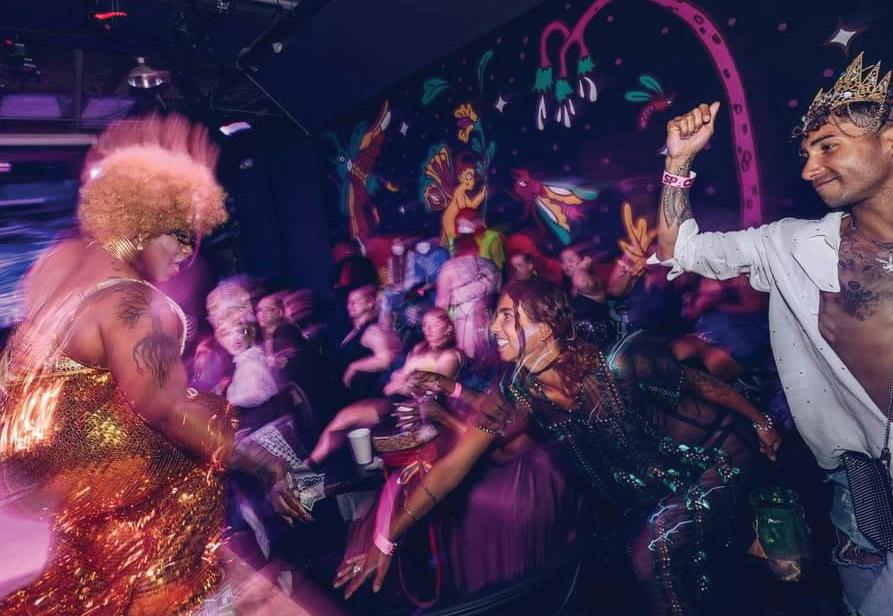
13 AND FEB. 15
In an epic all-out benefit performance night for Capital City Pride, the Free Range Revue presents the NightOUT extravaganza in two iconic themes at the Bank of NH Stage. December’s show, entitled “Something in the Wind,” pays tribute to the “Nightmare Before Christmas,” while February celebrates Black History Month as the Black Legends Revue. The event’s pay-what-you-want format gives all proceeds to Capital City Pride, an organization working toward an equitable future for New Hampshire by fostering events to celebrate and promote a positive image of the LGBTQIA+ community. Starting at 7 p.m., tickets start at $20, with a VIP tier available for just $10 more with swag and preferred seating. Tickets available at ccanh.com.
To submit multicultural or changemaker events for the next issue, send them to editors@603diversity.com.
COMPILED BY YASAMIN SAFARZADEH / COURTESY PHOTOS

Monthly meetings tackle education, air monitoring, healing circles for adults and teens, and an economic justice committee. The online meetings take place in the evening both virtually and in person. The Manchester Neighbors Welcome Meeting takes place 4 to 5 p.m. Nov. 18 virtually. Check out naacpmanchesternh.com for more information.
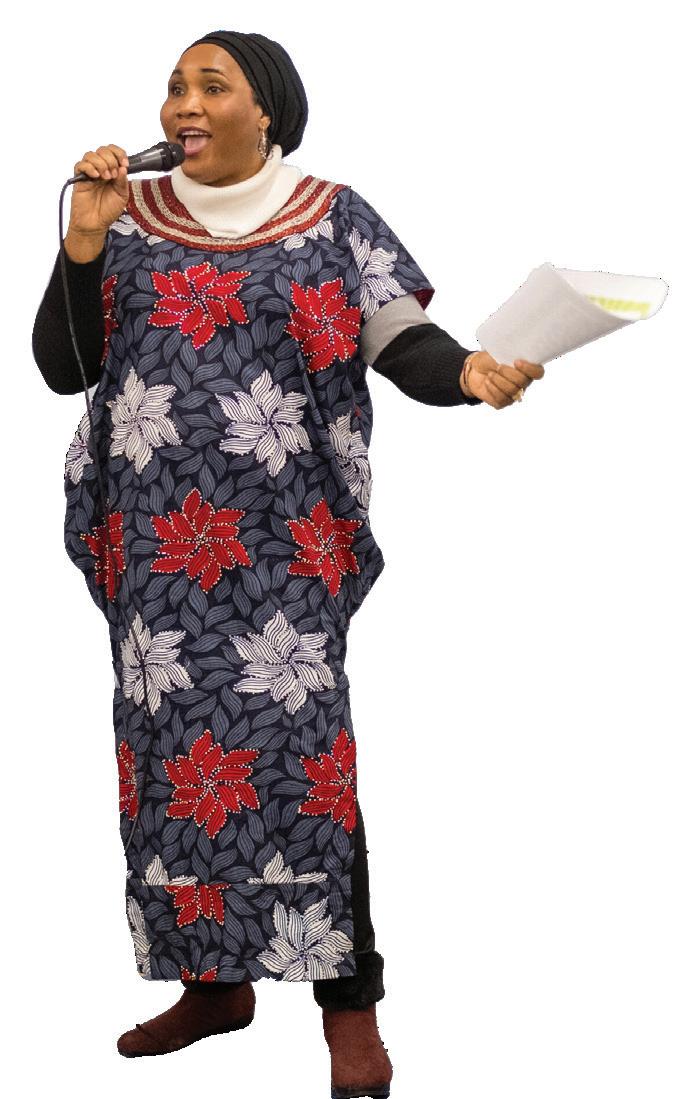
MCAC is continuing to host conversations regarding what fair and just education means for students and families of color. MCAC additionally mobilizes resources to create more pathways to opportunities, connecting families with one-on-one coaching, home visits, and navigating support and organization. MCAC acts as a mediator and facilitator to move the resources in the hands of families who can utilize them. Town Hall Meeting to take place Nov. 7 hybrid, 5 to 6:30 p.m., mcacnh.org. Please reach out to Kile Adumene for more information at kile@mcacnh.org.

NOV. 21
Waypoint NH is proud to partner with Positive Street Art, MYTURN NH and Opportunity Networks to bring a groundbreaking intersectional art gallery to the Manchester creative economy. The exhibition, entitled ‘Burgeoning’, is hosted at the Greater Manchester Chamber at 54 Hanover St., Nov. 21 from 6 to 8 p.m. A celebratory display of the rising legacies of a diverse group of local artists enriching the arts and cultural scene of our state, the exhibition features work from a variety of mediums. This accessible local display uplifts many of the region’s arts communities and individuals who are often overlooked, giving an audience and platform to the voices of underserved artists. Contact yasamin@ positivestreetart.org to schedule interviews or private tours.

Join fellow expecting and experienced parents for a community panel, conversation and discussion about support, tips and questions for new and experienced parents at the Arlington Street Community Center at 3 p.m. Come to seek and share opinions, thoughts and advice on parenting and supporting your children throughout new parenthood. Inquire for more information and register today at asccnashua@gmail.com or asccnashua.com.

Local nonprofit Queerlective, which creates and promotes events and environments for queer, BIPOC and other underserved communities, hosts a variety of events including a biweekly queer book club Mondays over Zoom at 6 p.m. Queerlective’s Queer Dungeons and Dragons group is also accepting rolling applications, and is in particular need of dungeon masters! Newsletter signups and further information at queerlective.com/pages/events.

DEC. 13
World-renowned chocolatier Richard Tango Lowry continues to bring fine chocolate tasting to the Queen City with Dancing Lion’s intimate guided experiences. Author and James Beard Award recipient Rowan Jacobsen teams up with the local shop for a signing of his newest
book, “Wild Chocolate: Across the Americas in Search of Cacao’s Soul,” along with an exclusive tasting menu of rare chocolates. The wild and heirloom quality chocolates are highlighted in the book, with all guests receiving a signed copy included with the purchase of their ticket. $25 from each ticket sale will be donated to Heirloom Cacao Preservation, in support of cacao farmers and communities. Tickets available at dancinglionchocolate.com, limited seats available.

BY EMILY REILY
Two New Hampshire professionals and members of the Latina community have been recognized for raising awareness of substance use and suicide prevention issues in the state.
Though their jobs differ, their goal is the same: connecting with and strengthening communities.
Lisa Vasquez, of Nashua, received the Certified Prevention Specialist of the Year award from the Prevention Certification Board of NH on June 6. At the time, she was a behavioral health strategist and member of Nashua’s Division of Public Health and Community Services, Greater Nashua Public Health Network. She believes she is the first Latina to achieve this award.
“It does feel pretty cool (to be recognized),” says Vasquez.
Vasquez’s work within Nashua
included facilitating strategic planning, nurturing community connections and creating a successful proposal to incorporate a social worker into the Nashua Police Department.
She also has made strides toward communicating with others across language barriers.
She previously worked on a podcast about mental health, “Speaking Our Mind,” which is conducted in five languages. In each episode, five hosts discuss a topic in English, Spanish, Portuguese, French and Swahili.
Since 2016, Vasquez has also worked on substance use disorder issues.
Vasquez, who is continuing her work in behavioral health for a different agency, notes the language barriers that exist.
“How do people access services if

they don’t speak English? I speak Spanish, and that has been something that I’ve been focused on for the Latino community, but also all communities, and making sure that anything we do is able to be accessed by people who don’t speak English,” says Vasquez.
On June 20 in Concord, Catalina Kirsch received the NAMI NH Systems Transformation Leader award. Kirsch is a continuum of care facilitator with the Carroll County Coalition for Public Health, an initiative of Granite United Way.
As part of the coalition, Kirsch brings awareness to the state’s mental health care system by promoting substance use prevention, treatment and recovery in the Carroll County Public Health Network.
As one of three suicide-prevention teams in New Hampshire, Kirsch, connects youth with mental health supports and services. Kirsch says financial barriers can prevent access to these vital health services, creating gaps in care.
“There are economic disparities in every community in New Hampshire. So a lot of our work is about equity and access to the services and opportunities that people need to be well,” says Kirsch.
Vasquez and Kirsch both say these public acknowledgments can pave the way for other Latina professionals to make a difference in their community. 603








